1. Emergence of Two Power Blocs
- Books Name
- Education Vision Political Science Book
- Publication
- PathSet Publications
- Course
- CBSE Class 12
- Subject
- Political Science
EMERGENCE OF TWO POWER BLOCS
Cuban Missile Crisis
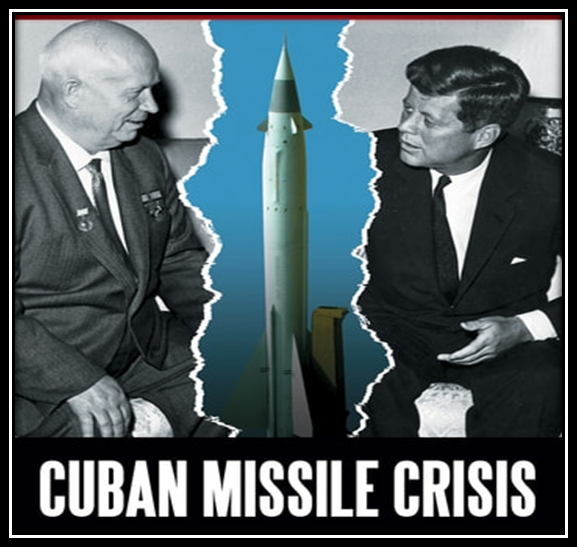
- Cuba was an island closer to US but it was ruled by USSR
- Cuba got all aids from USSR
- Cuba was a communist government ruled country
- In April 1961, USSR’s president worried that US might invade Cuba and throw off President Fidel Castro (president of Cuba).
- So, the president of USSR -- Nikita Khrushchev made Cuba Military base and placed nuclear missiles at the coast of Cuba.
- US became a bit afraid because the place where the missiles was placed by USSR, many states of US were near to it and US could not afford to lose them.
- After 3 weeks US became aware of the missiles placed my USSR.
- President of US – John F. Kennedy.
- US And USSR were having many nuclear weapons with intensity of 10 – 1500, which could destroy the whole world.
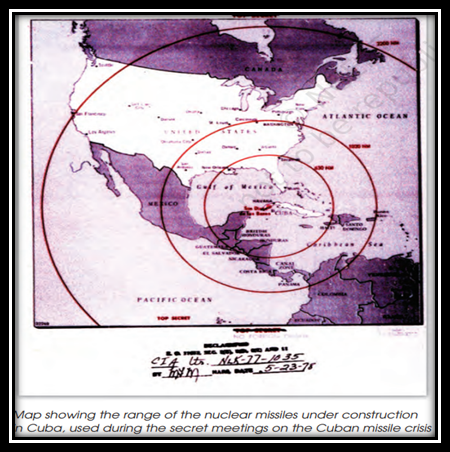
- US warned USSR, that If they say any missile approaching towards them, they will have to start the war.
- After the US made the statement USSR backed off and removed the missiles.
- And this war between US and USSR came to be known as CUBA MISSILE CRISIS because it created tension in the whole world.
- Cuba missile war was higher starting point of starting cold war.
The Cold War Rivalry
Reasons for Cold War between US and USSR
- Most important reason was their difference IDEOLOGIES as US favoured liberal,democracy and capitalism and USSR favoured socialism and communism.
- US wanted a multiparty or two-party dominance; USSR wanted one party dominance.
- Communism- Labours work for collective good, i.e., for govt and state.
- Capitalism- Refers to as individual gain, i.e., private gain.
- Alliance- a relationship based on similar interests.
COLD WAR
- It started after the end of World War II (1945).
- After the WW II ended US dropped 2 nuclear bombs to
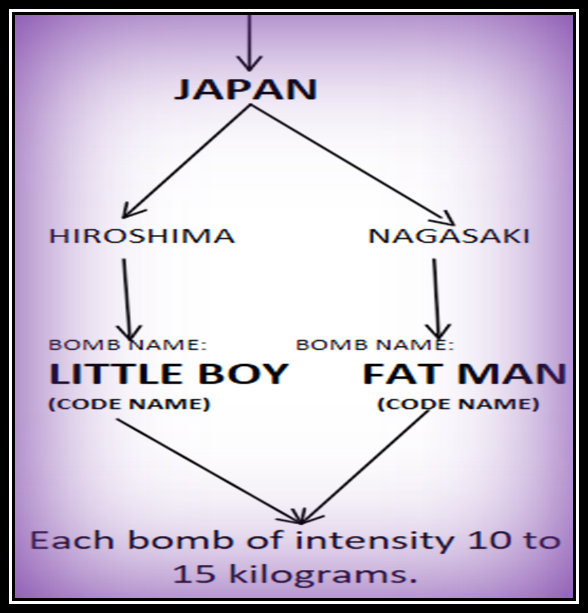
- And Japan surrendered.
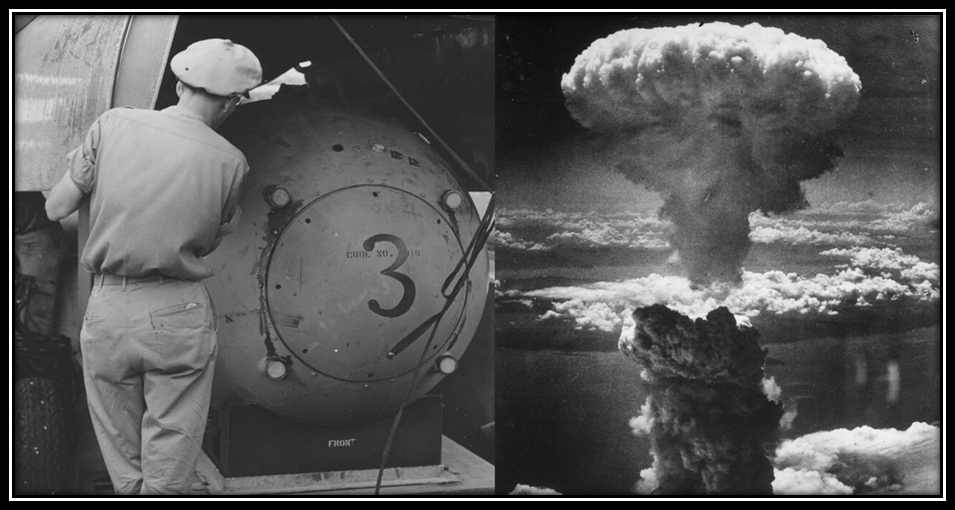
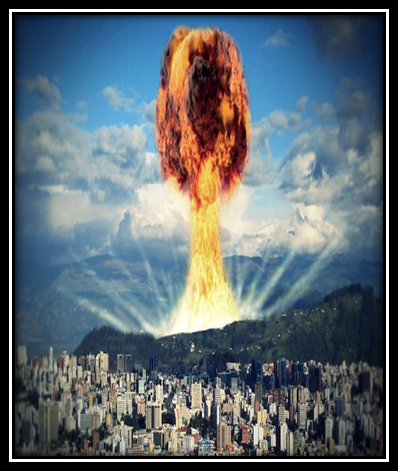
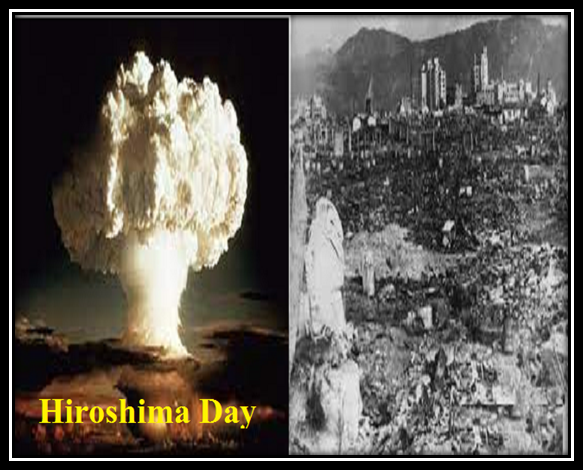
LOGIC OF DETERRENCE:
Means if both countries fought together then It will be difficult to announce winner because both have extreme nuclear power and both can destroy each other.
---- No one will be winner
---- NO political gain
--- No economic gain
And that is why both the countries decided to adopt LOGIC OF DETERRENCE.
Military feature of Cold War:
If two countries have logic of deterrence the then they avoid war so countries have to stay rational and responsible, i.e., that is maintaining good relations and taking care of nuclear weapo
Emergence of Two Power Blocs
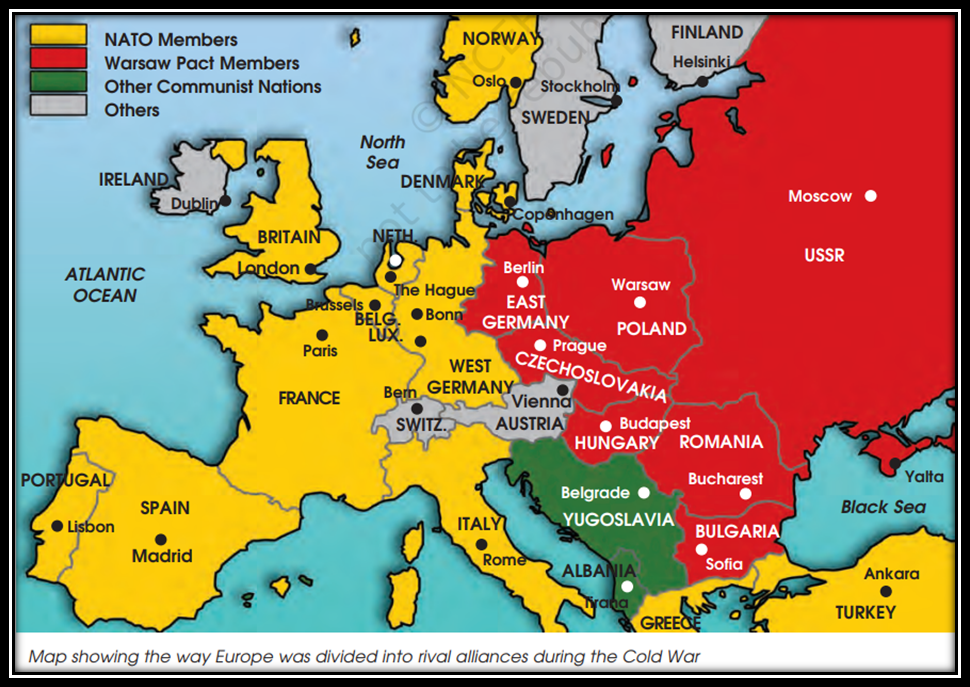
- The two superpowers i.e., the US and USSR wanted to expand their influence on the rest of the world.
- While expanding to the other states USSR and US promised of protection, weapons and economic aid against the state’s local rivals, mostly regional neighbours.
- The first division took place in Europe. Most countries of Western Europe sided with the US and were known as 'Western alliance’.
- The Western alliance formed itself into an organisation known as North Atlantic Treaty Organisation (NATO). It came into existence in April, 1949 with twelve states namely Belgium, Canada, Denmark, France, Iceland, Italy, Luxemburg, Netherlands, Norway, Portugal, US and UK.
- The NATO declared that armed attack on any one of them in Europe or North America would be regarded as an attack on all of them.
- In East and South East Asia and in West Asia (Middle East), the United States built an alliance system called the South-East Asian Treaty Organisation (SEATO) and the Central Treaty Organisation (CENTO).
- The countries of the Eastern Europe joined the USSR and came to be known as ‘Eastern Alliance’
- The Eastern alliance, also known as the Warsaw Pact, was led by the USSR was established in 1955. Its principle function was to counter NATO's forces in Europe.
- Communist China quarrelled with the USSR towards the late 1950s and in 1969 they fought a brief war over a territorial dispute.
- The other important development was the Non-Aligned Movement (NAM), which gave newly independent countries a way of staying out of the alliances.
- The smaller countries were of more help to the superpowers because they were the means to gain vital resources such as oil and minerals; locations to spy each other and to launch weapons.
Arenas of The Cold War
- US and USSR were having cold war but they did not have war in their territory they used do wars in Alliance states.
- Arenas: Area where wars occurred or threated to occur between alliances system but did not cross limits ad there was no nuclear war.
- Cold war was also responsible for many shooting wars such as:
- Korean War (1950 – 1953) – Jawahar Lal Nehru, the key leader of NAM helped negotiate/end war between the two Korea’s.
- Afghanistan War (1979 – 1989)
- Vietnam War (1954-1975)
- Cuban Missile Crisis
- Berlin (1948-1949)
- Congo War (early 1960’s) – UN Secretary-General mediated/stopped the war.
- US and USSR always had fear of war so they used to stay ready by: -
- Stocking arms and ammunitions in huge quantity
- Collecting nuclear weapons
- Military setup
- USSR thought what if someone tries to start a war intentionally/ some soldiers fires a missile intentionally to start a war.
- Therefore, they decided to collaborate in eliminating/limiting certain nuclear weapons and “Arms Control” was introduced.
- They signed 3 treaties/ agreement –
- Limiter Test Ban Treaty (LTBT) -1963
- Nuclear Non- Proliferation Treaty (NPT)- 1968
- The Anti- Ballistic Missile Treaty
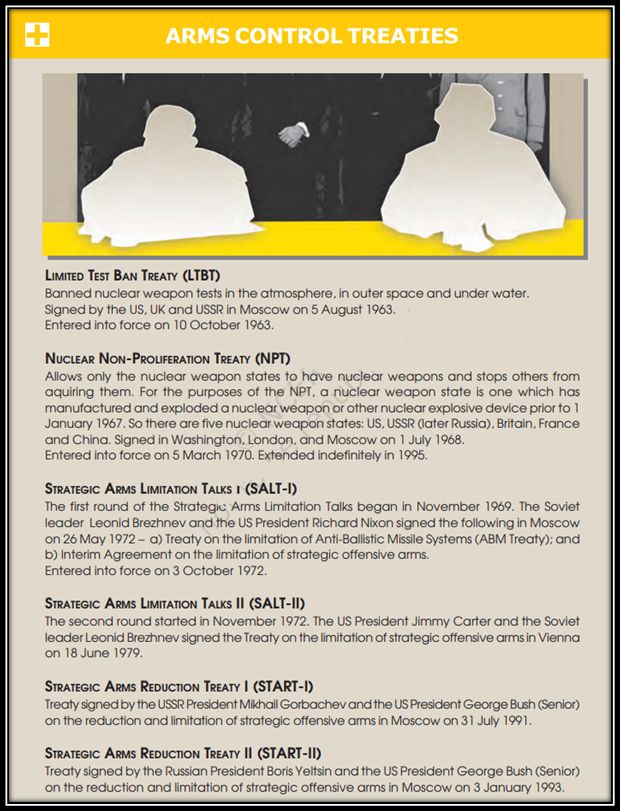
2. Non-Aligned Movement(NAM)
- Books Name
- Education Vision Political Science Book
- Publication
- PathSet Publications
- Course
- CBSE Class 12
- Subject
- Political Science
NON-ALIGNED MOVEMENT (NAM)
Countries which did not want to become the alliance of US and USSR, wanted to stay out from war and got independence with very difficult at their time.
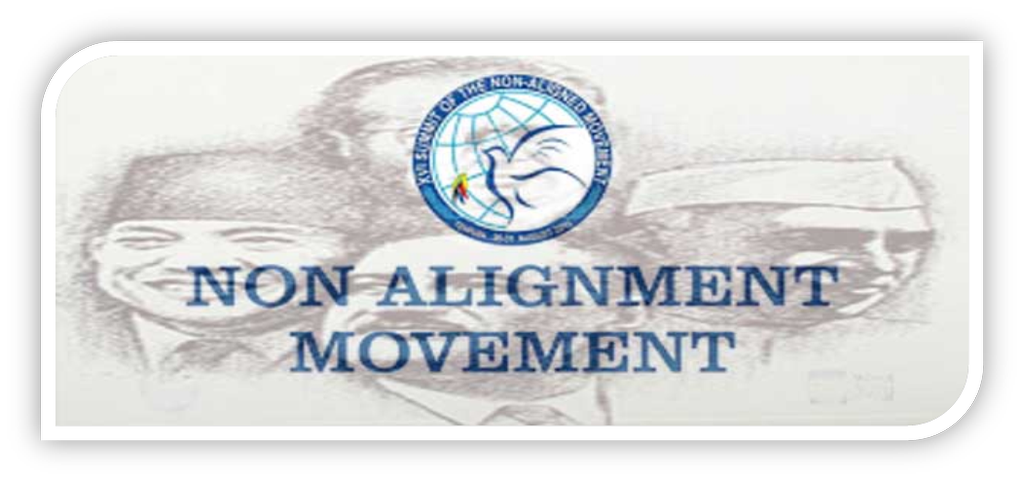
Countries which were in NAM: -
- Yugoslavia – Josip Broz Tito
- India – Jawahar Lal Nehru
- Indonesia – Sukarno
- Egypt – Gamal Abdel Nasser
- Ghana – Kwame Nakrumah
It was initiative by 5 countries for forming a 3rd world.
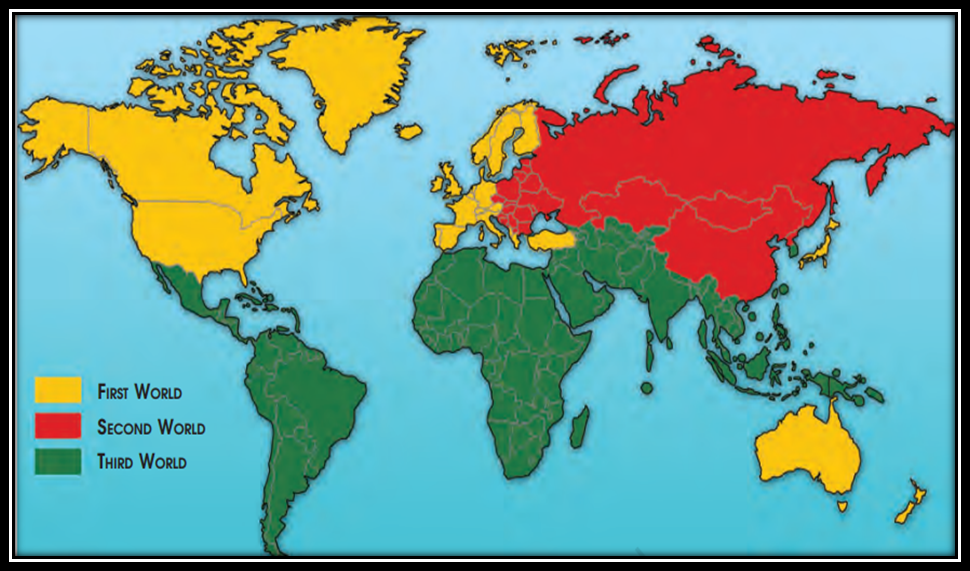
1. Challenge to Bipolarity
- NAM came to challenge US and USSR.

- Newly decolonised countries of Asia, Africa and Latin America were offered a option by NAM to not join any of the alliances and they were included to NAM.
- 1st NAM summit was held in 1961 in Belgrade and was attended by 25 states.
- Latest meeting i.e., 18th summit was held in 2019 at Azerbaijan and was attended by 120 member states and 17 observer countries.
- NAM was mainly founded by 3 leaders – Josip Broz Tito (Yugoslavia), Jawahar Lal Nehru (India) and Gamal Abdel Nasser (Egypt). And were further strongly supported by Sukarno (Indonesia) and Kwame Nkrumah (Ghana).
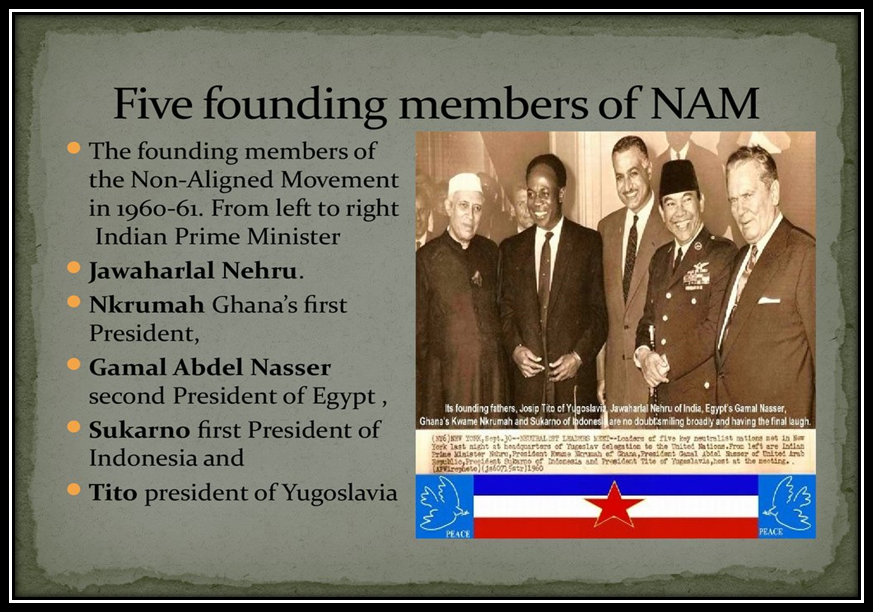
- NAM was defined by 2 Principles which they did not follow:
- Isolation: Remaining aloof from world affairs.
- Neutrality: Staying out of war or not taking any position in war
2. New International Economic Order
- NAM was a mediator between US and USSR but it had its own challenges and Problems:
1. Many countries in NAM came in the category of LDC’s (least developed country), as they were newly decolonised at that time. So, important challenge for NAM was to become economically developed.
2.Development was important because if not then NAM countries would have to been dependent on other rich countries for their needs.
- The idea of NEW INTERNATION ECONOMIC ORDER (NIEO) :
-
- UNCTAD (The United Nations Conference on Trade and Development) brought out a report in 1972.
- Report name/entitled - “Towards a New Trade Policy for Development”
4 reforms of Global trading system were discussed in the Report:
- Give the LDCs control over their natural resources exploited by the western countries,
- Obtain access to Western markets so that the LDC’s could sell their products and, therefore, make a trade more beneficial for poorer countries.
- Reduce the cost of technologies from western countries, and
- Provide the LDC’s with a greater role in international economic situations.
-
- For NAM countries economic issues became important.
-
- In the first summit NAM did not give much importance to economic issue but from mid-1970’s NUM started giving importance to it.
-
- NAM become an economic pressure group in 1970’s.
-
- By 1980’s the reforms started fading/ western countries stopped following it.
-
- And by 1980’s all the western countries united and started opposing the reforms by NIEO
3.India and The Cold War
- The responses of India towards Cold War were in two folds:
- Staying away from alliances i.e., not becoming part of USA or USSR.
- Raising voice against newly decolonized countries becoming part of the alliances, because the they become free from the British rule just at that time.
- India’s Policy:
- India’s policy was neither naïve nor passive.
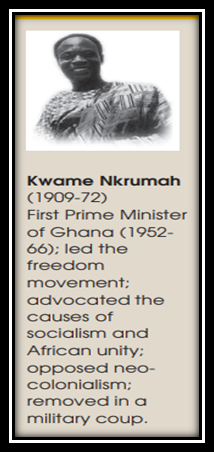
- Non – Alignment was not the policy of “Fleeing Away”
- In fact, India played a big role in softening the cold war rivalries.
- India played a major role reducing the differences between alliances thus preventing it from escalating in a full-scale ware.
- Indian leaders and diplomats used to often communicate to the rivals to mediate the issue, such as in Korean War.
- Most importantly, India also involved and activated regional and international organizations which were not the part of alliances, to soften the situation.
- Nehru also reposed a great faith in “a genuine commonwealth of free and cooperating nations” that would play a positive role in softening, if not ending the war.
- Therefore, we can say India played big role in the war.
The Non-Alignment Policy also benefited India directly in two ways:
- It allowed India to take international decisions and stances that served India its interests rather than the interests of super powers and their allies.
- India had the power to balance one super-power against the other. If India felt ignored or unduly pressurised by one super-power, it tilted towards the other. Therefore, no alliance system could take India for granted or bully it.
India’s Policy of Non-Alignment was often criticized on a number of counts.
Two of them were:
1. UNPRINCIPLED:
India’s NAM was called unprincipled because, in the name of serving personal interests India never used to take a firm stand on the international issues.
2. INCONSISTENT:
India was inconsistent as it often used to take contradictory postures, because India signed Treaty of Friendship with USSR in August 1971 and some people saw it as joining USSR.
Indian Government reply to the criticism was that India needed diplomatic and military support during Bangladesh crisis and that never stopped India from having good relations with US.
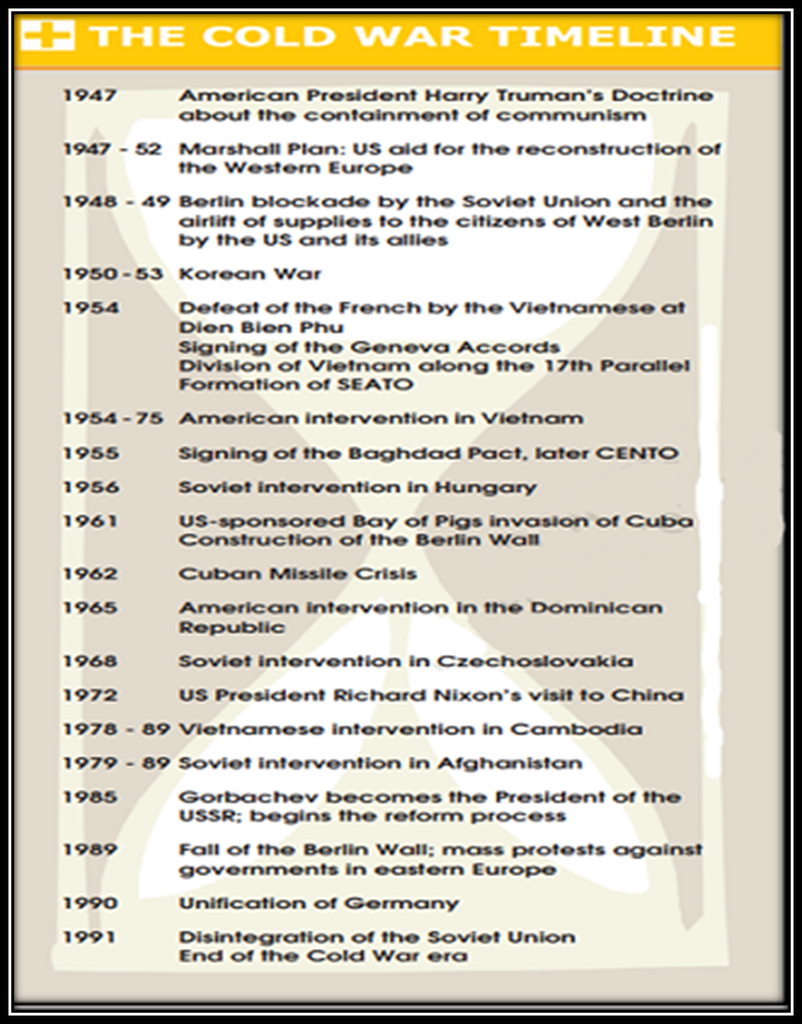
1. What was the Soviet System?
- Books Name
- Education Vision Political Science Book
- Publication
- PathSet Publications
- Course
- CBSE Class 12
- Subject
- Political Science
END OF BIPOLARITY
- Bipolar: Two poles i.e., 2 superpowers
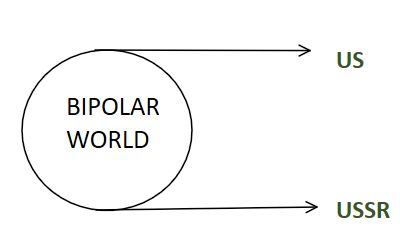
- Bipolar World ended and Unipolar world started.
- Berlin (i.e., Germany) was divided in 2 parts. East Berlin and West Berlin by the construction of Wall in 1961
- Division led because of difference in ideologies. West Berlin supported Capitalism and East Berlin followed Communism.
- 9th November 1989 wall between West and East Berlin was broken and everyone united and adopted Capitalism.
- It was remarkable in the world history and Unipolar World started.
- Many collapses like this happened and USSR disintegrated.
- US became the superpower.
WHAT WAS THE SOVIET SYSTEM?
The Union of Soviet Socialist Republics (USSR) came into being after Russian Revolution in 1917.
1. Soviet Union POLITICAL SYSTEM:
- COMMUNISM:
- Economy was planned and controlled by government.
- One party dominance and no opposition
- Communist party in USSR
- East Europe was part of USSR and followed same ideology of communism. And this group of countries was called the Second World or the “socialist bloc”.
- The military alliance (Warsaw Pact) held them together.
- The USSR was the leader of bloc.
2. The soviet economy was very developed than the rest of the world except US. Features being:
- Had complex communication network, vast energy resources including oil and minerals.
- Transport sector which connected its remotest areas with efficiency.
- It had domestic consumer industry that produced everything from pins to cars, though their quality did not match to the quality of western countries.
- Ensured minimum standard of living, all the basic amenities were provided by government.
- No unemployment.
- State ownership was dominant
3. Problems of USSR or in USSR:
- It was very bureaucratic and authoritarian i.e., strict rules and regulation imposed on citizens

- No Democracy
- No freedom of speech, people expressed their opinions through jokes and cartoons.
- Communist party had tight control over institutions and was unaccountable to people of USSR.
- And such institutions which needed reforms were ignored by government.
- The communist party refused to recognize the urge of people in 15 different republics (Russia + 14 states) that formed the Soviet Union.
- On papers 15 republics together constituted the USSR, but in reality, Russia dominated everything and people of other regions felt suppressed/ neglected.
4. In arms race USSR managed to match the US but USSR lagged behind from US in:
- Technology
- Infrastructure
- Fulfilling the political or economic aspirations of citizens.
- USSR invaded Afghanistan in 1979 because of which the USSR’s system weakened.
- Wages continued to grow but productivity and technology got far behind.
- Which led to shortage in customer goods.
- Food imports increased.
- And in the late 1970’s the Soviet economy became stagnant.
1. Evolution of The UN
- Books Name
- Education Vision Political Science Book
- Publication
- PathSet Publications
- Course
- CBSE Class 12
- Subject
- Political Science
EVOLUTION OF THE UN
Why International Organizations?
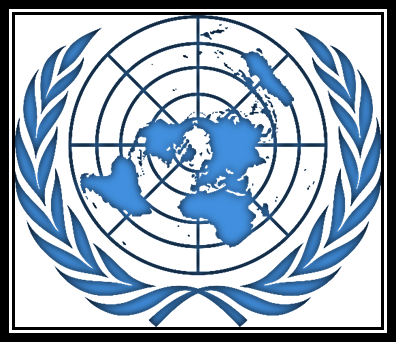
- UN is regarded as most important international organization.
- UN is great hope of humanity
- The United Nations was not created to take humanity to heaves but to save it from hell- Dag Hammarskjold
- International Organization helps sought out matter of war.
- Countries have conflicts and differences that does not mean they should go for war;
countries have UN as a platform to solve their issues - UN i.e., International organization is not a state or super state with authority over its members.
Importance of International Organization?
- There are some issues that can only be dealt when all countries are together.
- E.g.- Disease, Global Warming, Population control etc. aids, small pox etc.
- An international organization help to produce ideas that how to co-operate and provide a mechanism, rules and bureaucracy.
- International organizations are not the answers to everything but they are helpful to ensure world peace by solving problems peacefully.
- Joint efforts of all the nations are required to resolve certain global issues.
- An international organization is helpful to co operate the efforts of the nation of states.

Evolution of the UN
- After the first World War, world invested in international organizations to resolve conflicts. League of nations was born but it could not prevent war as a result Second World War (1939-45) took place and many people died.
- UN was formed as a successor to the League of Nations after the Second World War in 1945.
- Organisation was setup by signing of United Nations charter by 51 member/ countries.
- Objectives
-
- Peace and cooperation
- Minimizing war
- Social economic development
-
- By 2006 UN had 192 members. They are included in UN General Assembly with one vote (India is also a member)
- UN Security Council have five permanent members. All of them were made the permanent members because, they were powerful after the Second World War.
-
- US
- UK
- France
- China
- Russia
- They permanent members have veto power.
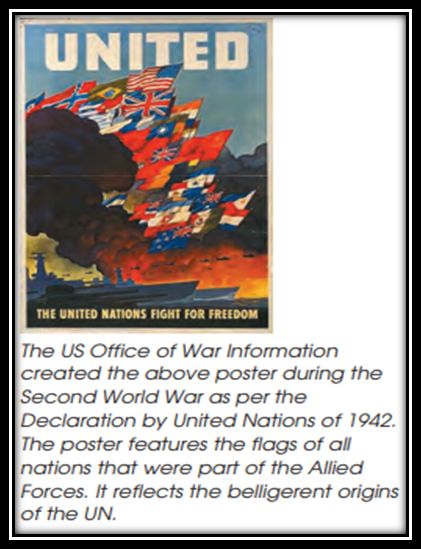
-
- The UN’s representative head is the Secretary-General.
- The present Secretary General is Antonio Guterres, he’s the 9th secretary general of the UN, he took over as a secretary general on 1st January 2017. He was the Prime Minister of Portugal from 1995 to 2002 and the UN High Commissioner of refugees from 2005 to 2015.
- The UN has many organizations like – WHO, UNDP, UNHRC, UNHCR, UNICEF, UNESCO and many others.
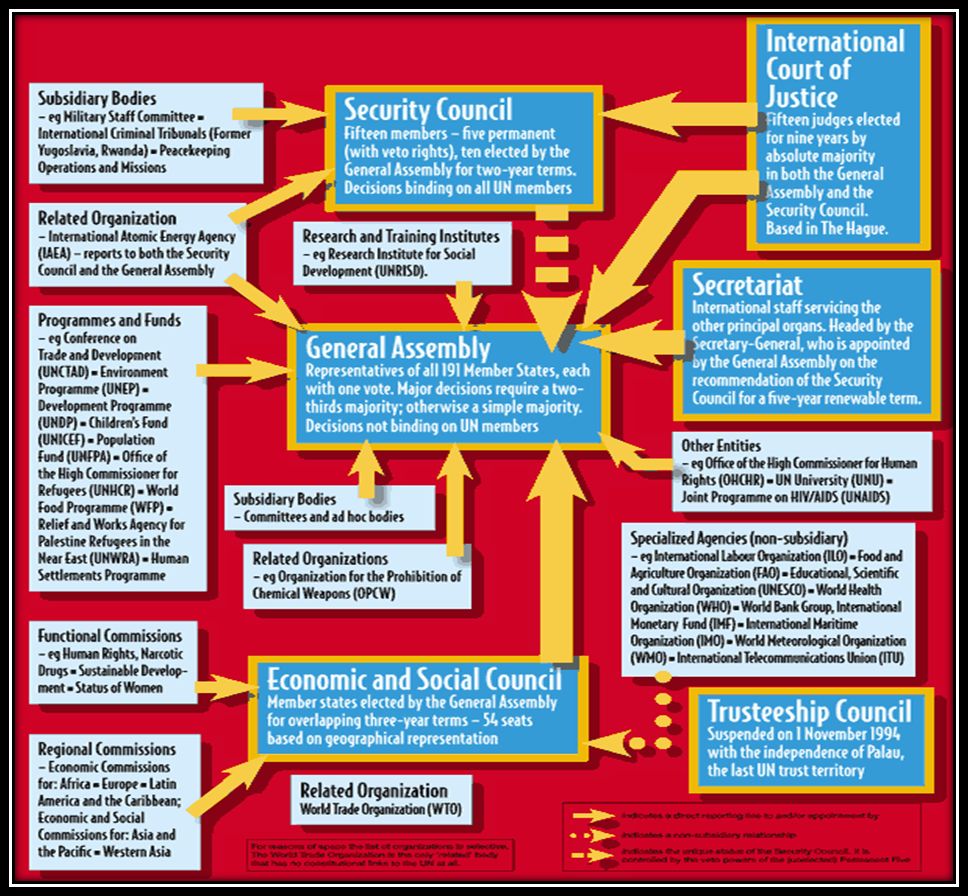
3. Reform of the UN after the Cold War
- Structural and Processes Reforms:
-
- Functioning of Security Council, the demand for increase in UN Security Council permanent as well as non-permanent members. So that realities of world politics are better reflected.
- Proposals to increase membership from Asia, Africa and South America
- US and other Western countries want improvements in the UN’s budgetary procedures and its administration.
-
- Jurisdictional Reforms
-
- Some countries wanted you want to play major role in peace and security missions, while others wanted its role to be confined to development and humanitarian work (health, education, environment, population control, human rights, gender and social justice)
-
- Changes that occurred after cold war
- Soviet Union had collapsed
- US was the new superpower
- China was fastest growing power and India was also growing
- Economics of Asia most developing
- Many new countries joined even after the disintegration of USSR
- New set of challenges were:
- Civil war
- Ethnic conflict
- Genocide
- Terrorism
- Climate change
- Environmental degradation
1. European Union Integration
- Books Name
- Education Vision Political Science Book
- Publication
- PathSet Publications
- Course
- CBSE Class 12
- Subject
- Political Science
European Union
- After Second World War Europe’s economy became worst, USA introduced “Marshall Plan”
- Marshall Plan (1948):
- Under the Marshall Plan, the organization for European Economic Cooperation was the established in 1948 it was made to help the western European states.
- The Organisation for European Economic Co-operation (OEEC) became a forum where the western European states began to cooperate on trade and economic issues.
- The Council of Europe was introduced in 1949, for political cooperation.
- Then European Economic Community was formed in 1957, then European Parliament was formed
- After the disintegration of USSR, European countries got confused at whether they should join USA or remain with USSR so therefore they formed European Union in 1992
- Did this to cooperate with foreign policy that is no war and peace everywhere.
- And decided to use common currency in European Union i.e., EURO
- European Union started behaving like nation state i.e., country
- It could not make its own constitution so it made its own flag, anthem, founding date, and currency.
- European Union had only a few members in the starting but soon it started to expand.
- EU has good economic, political and diplomatic, and military influence.
- The EU is the world’s second biggest economy with GDP of more than $17 trillion in the 2016 which is next to the United States of America.
- The EU possess a threat to the dominance US dollar.
- European Union’s share of world trade is much larger than that of the United states.
- European Union has influence over Africa, Asia and World Trade Organization (WTO) because of its economic power.
- European Union has influence over UN Security Council because Britain and France (countries in EU) are 2 permanent members of UN.
- The European Union also includes several non- permanent members of the UNSC, which enables European Union to influence some US policies such as the current US position on Iran’s nuclear program.
- Militarily, the EU’s combined armed forces are the second largest in the world.
- Its total spending on defense is second after the US.
- 2 EU member states, Britain and France, have nuclear arsenals of the approximately 550 nuclear warheads.
- It is also the world’s second most important source of the space and communication technology.
- As European Union is a supranational organization it is able to intervene in economic, political and social areas.
- European Union’s member states have their own Foreign Relations and different policies that are often at odds with each other.
- This limits the ability of the European Union to act in matters of the Foreign Relations and defense.
- Britain’s former Prime Minister Margaret Thatcher, kept the UK out of the European market.
- Denmark and Sweden have resisted the Maastricht treaty and adoption of the euro.
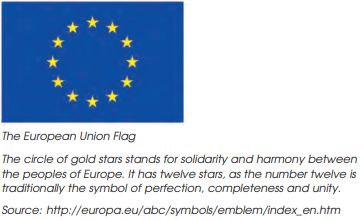
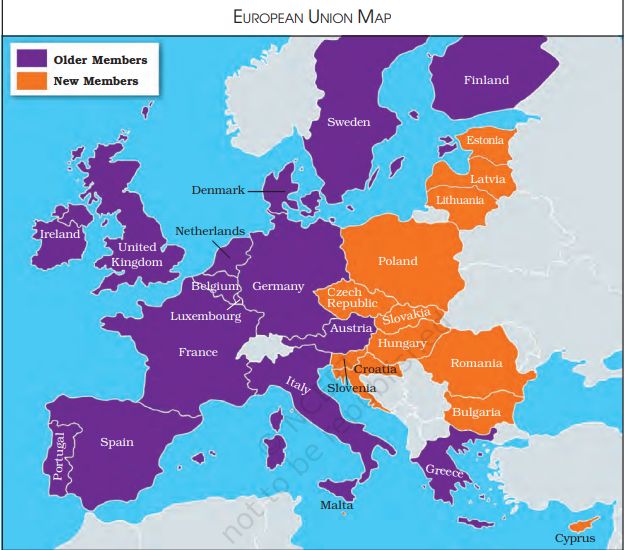
1. What is South Asia?
- Books Name
- Education Vision Political Science Book
- Publication
- PathSet Publications
- Course
- CBSE Class 12
- Subject
- Political Science
What is South Asia?
- South Asia includes:
- Bangladesh
- Bhutan
- India
- Pakistan
- Maldives
- Nepal
- Sri Lanka
- There is linguistic, social and cultural distinctiveness among the countries.
- The boundaries of countries are not clear.
- Afghanistan and Myanmar are often included discussion of the region as a whole.
- China is an important player but not included in this region.
- Political System in South Asia
- Sri Lanka and India have democratic system and have remained democratic since independence, despite of many conflict and various problems faced.
- Pakistan and Bangladesh have both experienced civilian and military rulers.
- Pakistan: it began democratic rule in post-Cold War period, under Bhutto and Nawaz Sharif. It suffered a military coup in 1999 and thereafter run by and civilian government again since 2008
- Bangladesh remained democratic in the post-Cold War period and thereafter followed it.
- Nepal was a constitutional monarchy, but after 2008 monarchy was abolished and Nepal became a democratic republic.
- Bhutan became constitutional monarchy in 2008, under the leadership of the king it has now emerged as a multiparty democracy.
- Maldives, was Sultanate till 1968 later transformed into republic with a presidential form of government.
- In June 2005, Maldives voted for multi-party system.
- The Maldivian Democratic Party dominates the political affairs.
- After 2005, democracy purely established and opposition party also emerged. The MDP won the 2018 elections.
- All the countries wanted to be in democracy and believed in global expansion of democracy.
- All the people view the idea of democracy positively and support institution of representative democracy.
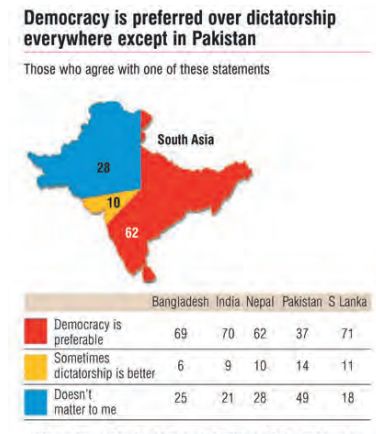
2. Gorbachev and the Disintegration of the USSR
- Books Name
- Education Vision Political Science Book
- Publication
- PathSet Publications
- Course
- CBSE Class 12
- Subject
- Political Science
GORBACHEV AND THE DISINTEGRATION OF USSR
- Mikhail Gorbachev the General Secretary of Communist party (USSR) in 1985.
- He brought reform in the USSR.
- He wanted to know the citizens of USSR and also wanted to be fully updated about the technological revolutions taking place in the West.
- He wanted to normalize the relationships with the west and democratize and reform the USSR.
- But this brought some effects which neither he nor anyone else anticipated:
- East European countries started protesting against their own government and USSR for democracy to be established. And one by one communist regimes started collapsing.
- At the same time economic system was of the USSR weakened which hastened the disintegration.
- Gorbachev initiated political and economic reforms and democratization within the country but the reforms were opposed by the leaders withing the Communist party.
- And the leaders of communist party started a coup in 1991.
- People now tasted the freedom and did not want to live in the old style.
- Boris Yeltsin became the national hero as he won the election in Republic Russia and opposed the coup.
- Eastern Europe demanded independence and Central Asian republics wanted to remain with Soviet Federations.
- In 1991, Russia, Ukraine and Belarus, the three major republics of USSR declared that USSR has disbanded.
- Capitalism and democracy were adopted for post- Soviet republics.
- USSR disintegrated, all states separated from Warsaw Pact and “Commonwealth of Independent States” (CIS) was introduced and this was a surprise for Central Asia republics.
- After disintegration Russia inherited the Soviet seat in the UN security Council.
- Russia accepted all the international treaties of Soviet Union.
- Only nuclear state was Russia and carried out some nuclear disarmament measures with the US.
- Old USSR buried and Russia was accepted as the successor state.
Why Did the Soviet Union Disintegrate?
- Weakness of the USSR’s economic and political institutions led to the disintegration:
1. Economic Weakness:
- The e
 conomic stagnation leading to severe consumer shortages of goods and services. As a result, the public was not satisfied and started doubting and asking questions openly, which was later followed by protests.
conomic stagnation leading to severe consumer shortages of goods and services. As a result, the public was not satisfied and started doubting and asking questions openly, which was later followed by protests. - Reasons of weak and stagnated economy:
- USSR used to spend money and resources in maintaining a nuclear and military arsenal.
- Spend money in development of satellite states in Eastern Europe and within USSR (basically in 5 Central Asian republics).
- People gained knowledge about the technological advancement in the West and started comparing.
2. Political Weakness:
- Communist party was ruling over 70 years and became authoritarian and was not accountable to people.
- Corruption started at high rate; government could not stop/reduce it.
- The people did not know about the functioning about the government/ political system i.e., lack of transparency between people and the government.
- Party bureaucrats gained privileges than ordinary citizens.
- People did not identify with the system and with the rulers and the government lost popular backing.
- Even after reforms of Gorbachev were introduced and promised to deal with the problems, USSR disintegrated. Why?
3. There were sections of society which believed that Gorbachev should have moved much faster, and he was disappointed and impatient with his methods.
4. Communist party had a opposite view and concerns, they felt that their power and privileges were eroding and Gorbachev was moving very fast.
- Therefore, Gorbachev lost support on all sides and divided the public opinion. People who were with him were disillusioned and felt he did not defend his own policies.
- The final and most immediate cause for the disintegration for USSR:
5. The rise of nationalism and the desire for sovereignty within various republics including Russia and the Baltic Republics (Estonia, Latvia and Lithuania), Ukraine, Georgia, and others.
2.Consequences of Disintegration
- There were many consequences of disintegration, but for now we will talk about only three:
1) End of Cold War Confrontation and Ideology Dispute
- The ideological dispute over whether the socialist system would beat the capitalist system was not an issue any more.
- As a result, the end of confrontation demanded an end to his arms race and a possible new peace.
2) Power relations in World Politics Changed:
- Two possibilities were there:
(i) Unipolar world- Only one republic will be dominant
(ii) Multipolar world- No one country will be dominant.
- But after Cold War US became the dominant republic and became unipolar.
- Capitalistic ideology was followed internationally.
- Institutions like World Bank and International Monetary Fund became powerful advisors and other countries took loan from them for developing.
- Now, the best way to organize the political life was liberal democracy.
3) Emergence of New Countries:
- The end of Cold War led to the emergence of many new countries.
- Baltic and east European states became part of NATO.
- Central Asian countries continued close ties with Russia and also established ties with the west, the US, China and others.
- All the new countries had their own independent aspirations and choices.
3. Shock Therapy in Post-Communist Regimes
- Books Name
- Education Vision Political Science Book
- Publication
- PathSet Publications
- Course
- CBSE Class 12
- Subject
- Political Science
SHOCK THERAPY IN POST-COMMUNIST REGIMES
- The collapse of communism was followed in most of these countries by a painful process of transition from an authoritarian socialist system to a democratic capitalist system.
- The model of transition in Russia, Central Asia and east Europe that was influenced by the World Bank and the IMF came to be known as ‘shock therapy’.
- Shock therapy varied in intensity and speed amongst the former second world countries, but its direction and features were quite similar.
- Features of Shock Therapy:
- Each of these countries was required to make a total shift to a capitalist economy, which meant rooting out completely any structures evolved during the Soviet period.
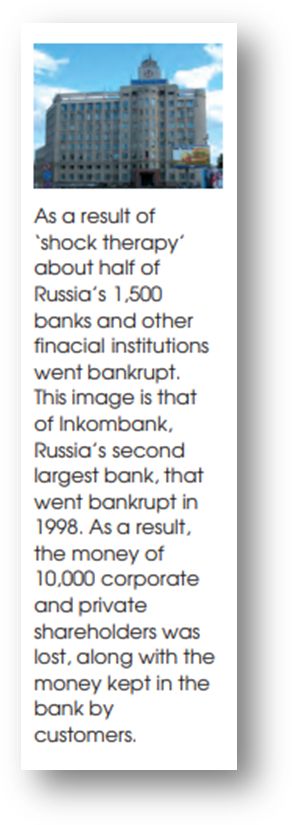
- Private ownership became the dominant pattern.
- Privatisation of state assets and corporate ownership patterns were to be immediately brought in.
- Collective farms were to be replaced by private farming and capitalism in agriculture.
- Shock Therapy also changed the external orientation of these economics:
- Development was now envisaged (to bring) through more trade, and thus a sudden and complete switch to free trade was essential.
- The free trade regime and foreign direct investment (FDI) were to be the main engines of change. Also involved:
- Foreign investment
- Financial Opening/de-regularisation
- Currency Convertibility
- Finally, the transition also involved a break-up of the existing trade alliances among the countries of the Soviet bloc:
- The states were to adopt the western eco system(capitalism).
- The Western capitalist states now became the leaders and thus guided and controlled the development of the region through various agencies and organisations.
Consequences of Shock Therapy
Bad results are:
- Largest – Garage sale
- 90 % of the state-owned industries were to put upon sales to private individual companies.
- Virtual disappearance of entire industries happened, they were undervalued and sold through auction at thrown away prices.
- All citizens were given vouchers to participate in sales, but many sold it in black market for extra money.
- De- regulation of currency
- The value of Russian currency “ruble” decreased.
- The rate of inflation was so high that people lost all they savings.
- The collective farm system disintegrated leaving people without food security and Russia, started to import food.
- In 1999 the GDP of Russia was less than that of the previous year
- Social-Welfare Declined
- The withdrawal of government subsidies pushed large sections of the people into poverty. Basic needs weren’t fulfilled now.
- The middle classes were pushed to the periphery of society, and the academic and intellectual manpower disintegrated or migrated.
- Mafia Emergence
- Many economics activities controlled by Mafia’s.
- Privatisation led to new disparities.
- Post-Soviet states, Russia, was now divided as rich and poor regions.
- Economic inequality between people started increasing at a high rate.
- Ignorance of Democratic Institution
- Construction of democratic institutions weren’t given much importance.
- As the constitution of countries were drafted in hurry, President was given high powers.
- In Central Asia, the presidents had great powers, and several of them became very authoritarian.
- The presidents of Turkmenistan and Uzbekistan appointed themselves to power for first ten years and then extended it for another ten years, not allowing any opposition to take place.
- No Judicial Culture
- A judicial culture and independence of the judiciary was yet to be established in most of these countries.
- Countries started reviving in 2000, as most of the countries were oil, gas and mineral rich countries.
- Azerbaijan, Kazakhstan, Russia, Turkmenistan and Uzbekistan were major oil and gas producers and exported them for money.
- Other countries on their territories got rent for the oil pipelines passing through them.
2.Tensions and Conflicts
- Most of the former Soviet Republics are prone to conflicts, and many have had civil wars and insurgencies, growing involvement of outside powers complicate the situations.
- Chechnya and Dagestan [Russian Republics]- had violent secessionist and movements.
- Moscow’s method of dealing with Chechen rebels and indiscriminate military bombing had led to many human right violations but have failed to deter the aspirations for independence.
- Tajikistan witnessed a civil war that went on for 10 years till 2001.
- The region as a whole has many sectarian conflicts.
- In Azerbaijan’s province of Nagorno-Karabakh, some locals Armenian’s wanted to secede and join Armenia.
- In Georgia, two provinces demanded independence which later turned out to be civil war.
- Countries and provinces are fighting over river waters, which makes ordinary citizens life difficult.
- The Central Asian Republics has areas with vast hydrocarbons resources, at the same time it has become a zone of competition between outside powers and oil companies.
- Region which next to Russia, China, Afghanistan, Pakistan and Close to West Asia, US wanted the military base in that region and paid to all Central Asian States to hire bases, and to allow airplanes to fly over their territories during the war in Afghanistan and Iraq. (After 11 September 2001)
- In easter Europe, Czechoslovakia divided themselves into two independent countries. i.e., the Czechs and the Slovaks.
- After 1991, Balkan republics of Yugoslavia was broken into independent provinces like Croatia, Slovenia and Bosnia and Herzegovina etc.
- Serbs opposed this, and a massacre of non-Serb Bosnians followed.
- The NATO intervention and the bombing of Yugoslavia followed the inter-ethnic civil war.
- Russia perceives these countries to be “Near Abroad” and tells these countries should be under their influence.
- China has interest because of oil resources and settling around borders to conduct trade.
3.India And Post-Communist Countries

- India has good relations with all states but it is stronger with Russia.
- India’s relations with Russia are an important aspect of India’s foreign policy.
- It is popular in history
- Russian people keep names after Bollywood actors.
- Bollywood song are popular in Russia and many post- Soviet countries.
- India and Russia share a vision of multipolar world order.
- More than 80 bilateral agreements have been signed between India and Russia as a part of Indo-Russia strategic Agreement of 2001.
- India has benefits with relationship, which being on:
- Kashmir Issue
- Energy supply (oil crisis)
- Sharing information on international terrorism
- Access to Central Asia
- Balancing relationships with China
- Military hardware’s from Russia
- Russia is important for India’s nuclear energy plans. Ex- Russia gave cryogenic rocket to India when we needed it.
4. Middle East Crisis
- Books Name
- Education Vision Political Science Book
- Publication
- PathSet Publications
- Course
- CBSE Class 12
- Subject
- Political Science
MIDDLE EAST CRISIS
5. Democratic Politics and Democratization
- Books Name
- Education Vision Political Science Book
- Publication
- PathSet Publications
- Course
- CBSE Class 12
- Subject
- Political Science
DEMOCRATIC POLITICS AND DEMOCRATIZATION
1.Commonwealth of Independent States (CIS)
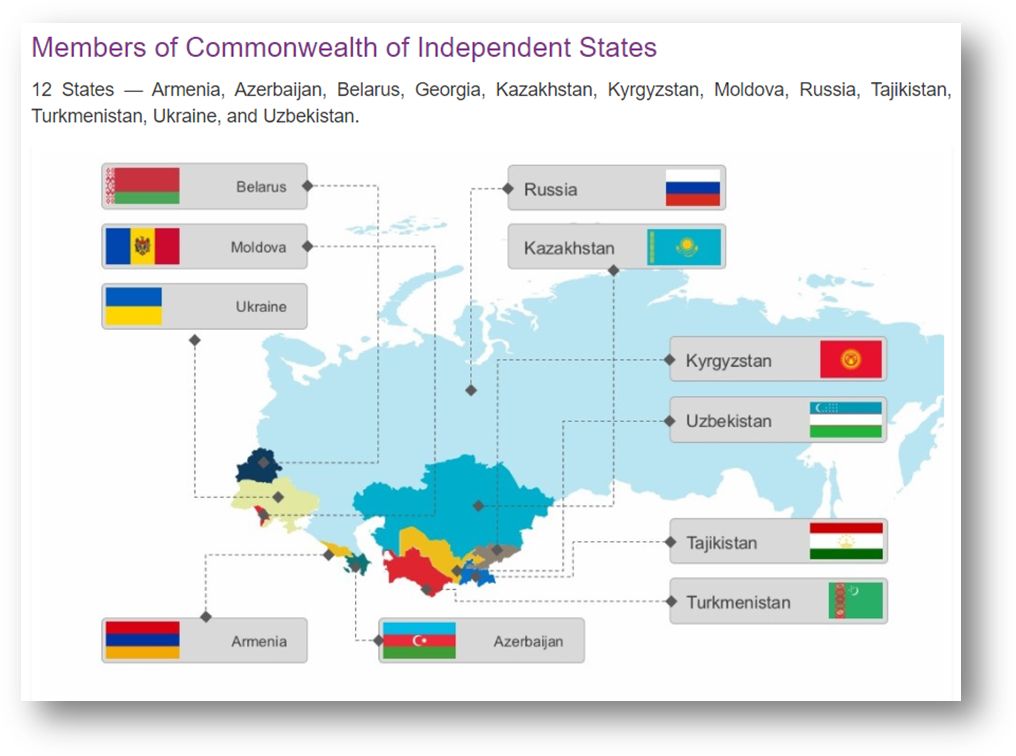
- CIS -> Commonwealth of Independent states
- Established on: 8th December 1991
- History:
In December 1991, Russia, Belarus and Ukraine formed a regional organization known as intergovernmental commonwealth of independent states (CIS), later on joined by Armenia, Kazakhstan, Azerbaijan, Turkmenistan, Tajikistan, Uzbekistan, Moldova and Kyrgyzstan.
↓
The objective of the formation of CIS was to cooperate on political, economic, environmental and other issues.
- Features and functions of CIS:
- The CIS has its headquarters at Minsk, Belarus,
- An Executive Director heads the CIS.
- The CIS is not a successor country to the Soviet Union. The CIS is an organization or alliance of independent countries.
- The Commonwealth of Independent States (CIS) meets periodically on a rotating basis at the capitals of the Member Countries.
- The CIS performs its activities based on the CIS Charter which was signed in 1993 in order to set up various institutions of the CIS and their rules and functions.
- It also mentions that the Commonwealth of Independent States shall serve in developing and strengthening trust, mutual understanding, friendship, Inter-ethnic accord and cooperation between the member states.
2.Arab Spring
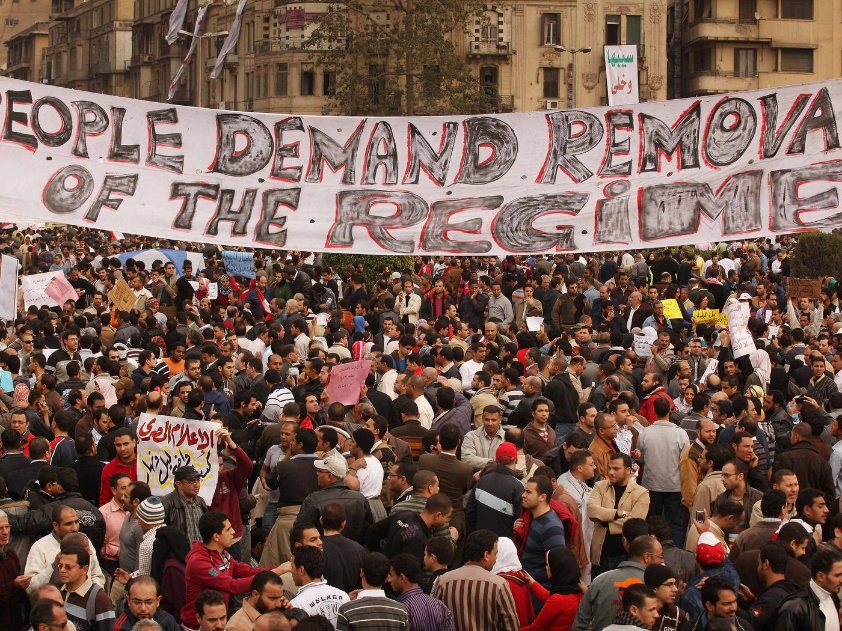
- The 21st century witnessed emergence of new developments for democracies and democratization in West Asian countries, one such event is characterized as Arab Spring that began in 2009.
- Located in Tunisia, the Arab Spring took its roots where the struggle against corruption, unemployment and poverty was started by the public which turned into a political movement because the people considered the existing problems as outcome of autocratic dictatorship.
- The demand for democracy that started in Tunisia spread throughout the Muslim-dominated Arab countries in West Asia.
- Hosni Mubarak, who had been in power in Egypt since 1979, also collapsed as a result of the massive democratic protests.
- In addition, the influence of Arab Spring could also be seen in Yemen, Bahrain, Libya and Syria where similar protests by the people led to democratic awakening throughout the region.
- Causes of Arab Spring were
1. Economic Causes
- The economic condition of the Middle East countries was very much deteriorating. The people were suffering from food crisis and low standard of living. Level of unemployment was increasing.
2. Social Causes
- The people did not have the social freedom to move freely or to express their opinions in the public. The government of dictator had the absolute rule over the whole society.
3. Corruption
- In Middle East countries the corruption was at its height during this this time. The business elites collaborated with the regime to exploit the masses
4. Rebellion
- Within a month of the downfall of Tunisian dictatorship in 2011, the protests spread to almost every Arab country, as people revolted, though with varying intensity, but the media helped to a great extent to give further encouragement to the rebellion.
5.Sudden cause
- The death of Mohammed Bouazizi, the street hawker of Tunisia led the inhabitants of Arab states to go against the despotic rulers. He committed the self-immolation as a protest in December, 2010, when his goods were taken away and he was humiliated at the hands of a female municipal officer.
- Result of Arab Spring:
6. Removal of Authoritarian rulers from Tunisia, Libya and Egypt-
- Most of the Middle Eastern countries were being ruled by the authoritarian rulers. Many of them ruled for decades so, after the revolt these despotic rulers were being removed from their thrones.
7. Political and Social Rights
- The rulers of Oman, Saudi Arabia, Morocco and Bahrain granted social and economic rights to their citizens.
8. Development of Public Political Sphere
- Arab Springs marked the formation of a public political sphere where common masses could discuss politics openly in the public places.
9. Emergence of democracy
- The revolt was a successful attempt at bringing democratic ideals in the Middle Eastern countries. The people got freedom from all the despotic shackles after long drawn war against it.
2. Reform of structures and processes
- Books Name
- Education Vision Political Science Book
- Publication
- PathSet Publications
- Course
- CBSE Class 12
- Subject
- Political Science
REFORMS OF STRUCTURES AND PROCESSES
- In 1992, the UN General Assembly adopted a resolution. The resolution reflected three main complaints:
-
- The Security Council no longer represents contemporary political realities.
- Its decisions reflect only western values and interest and are dominated by a few powers.
- It lacks equitable representation.
-
- On 1st January 1997, the UN secretary general Kofi Annan initiated an inquiry into how the UN should be reformed
- Criteria for selection of new permanent and non-permanent members of UN? was proposed. The criteria being:
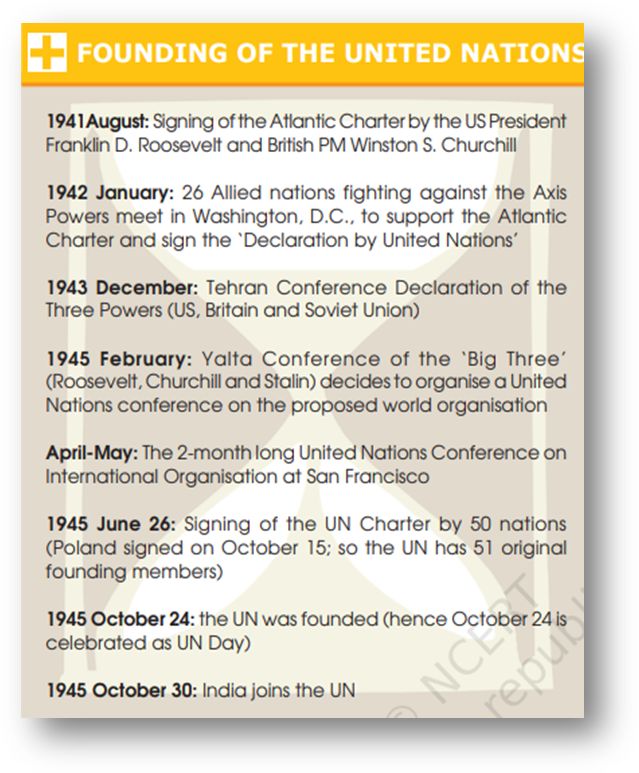
- A major economic power
- A major military power
- A substantial contributor to the UN budget
- A big nation in terms of its population
- A nation that respects democracy and human rights
- A country that would make the Council more representative of the world’s diversity in terms of geography, economic systems, and culture.
- Governments saw some advantages in some criteria and disadvantages in others depending on their interests and aspirations.
- Many issues were raised regarding it.
- In the Security Council there are five permanent members and 10 non-permanent members.
- The charter gives the permanent members a privileged position of permanency and the veto powers.
- The non-permanent members serve for only two years at a time and give away that period to new elected members.
- A country cannot be re-elected immediately after completing a term of 2 years.
- The non-permanent members are elected in a manner so that they represent all the continents of the world.
WHAT IS VETO POWER?
-
-
- In taking decisions, the Security Council proceeds by voting.
- All members have one vote.
- The permanent members can vote in negative manner so that even if all the other permanent and non-permanent members vote for a particular decision, any permanent members negative vote stall the decision.
- This negative vote is the veto.
-
WAS VETO POWER ABOLISHED?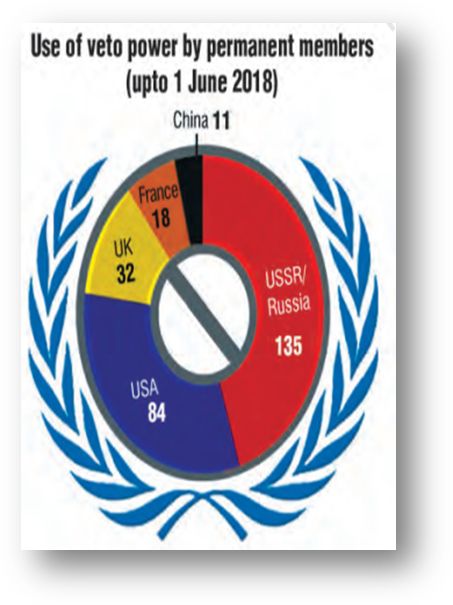
-
-
- Many perceived that veto power was no longer required.
- The permanent members are unlikely to agree to such a reform where the privilege of veto power will be taken away from them.
- It was believed that the world was not ready for such a radical step even though the Cold War was over.
- But without the veto, there is danger that the great powers would lose interest in the world body, and that they would do anything outside and without their support and involvement the body would be ineffective.
-
Jurisdiction of the UN
- The UN completed 60 years of its existence, the heads of all the member states met in September 2005 to celebrate the anniversary and review the situation.
- And they decided to take care of few steps, steps are as follows:
-
- Creation of peacebuilding Commission
- Acceptance of the responsibility of the international community in case of failures of national governments to protect their own citizens from atrocities.
- Establishment of Human Rights Council (operational since 19 June 2006)
- Agreements to achieve the Millennium Development Goals
- Condemnation of terrorism in all its forms and manifestations
- Creation of democracy fund
- An agreement to wind up the Trusteeship Council
-
- Many questions were raised regarding the steps to be taken.
- Questions like- what should the peacebuilding Commission do? There are many numbers of conflicts all over the world in which all should it intervene in? etc.
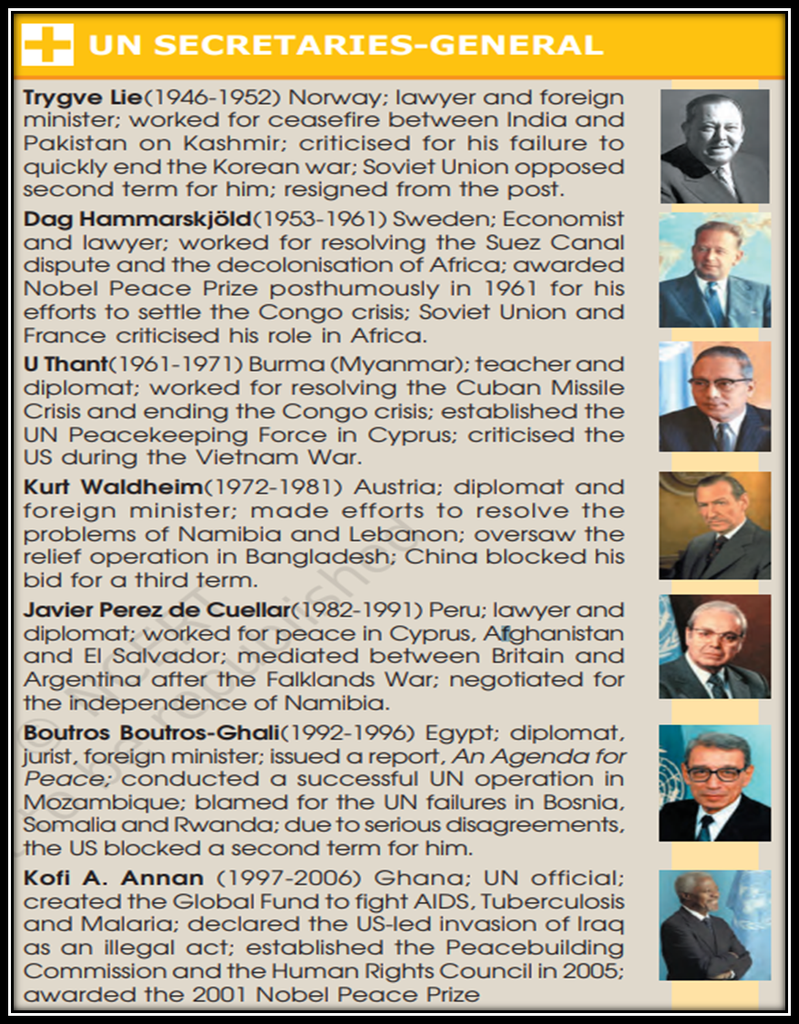
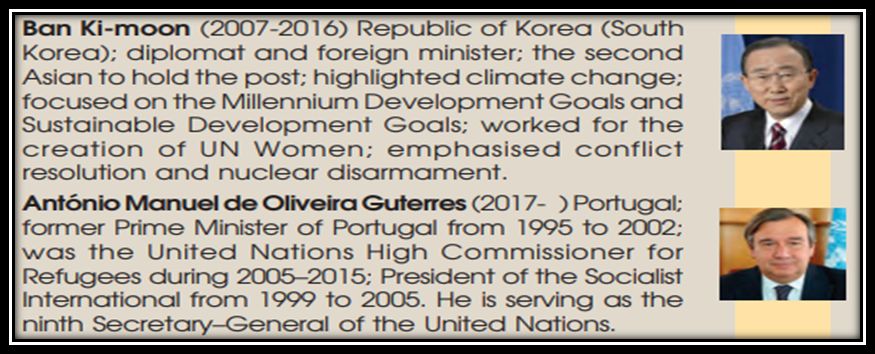
3. India and the UN reforms
- Books Name
- Education Vision Political Science Book
- Publication
- PathSet Publications
- Course
- CBSE Class 12
- Subject
- Political Science
INDIA AND THE UN REFORMS
- India has supported the structural reforms of the UN.
- India supports UN in promoting development and cooperation among states
India supports UN in many ways: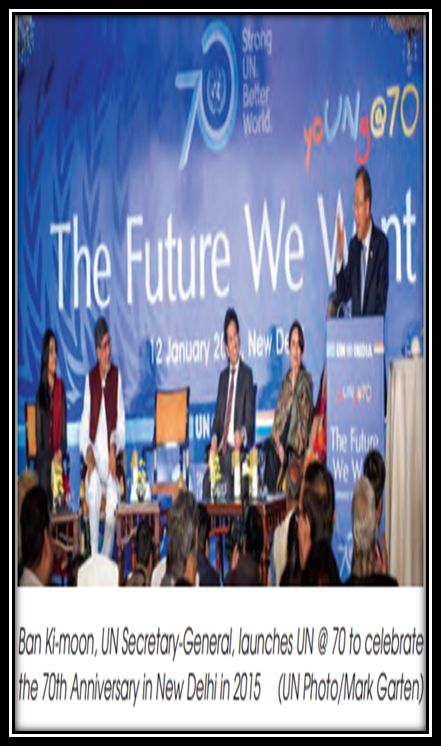
- Increasing peace and security:
- India accepts UN role in cooperation
- Social economic development should be main agenda
- International peace and security management
- Composition of Security Council:
- It has remained static and harmed representation
- Non-permanent members counters increased from 11 to 15 in 1965. But there is no change in the number of permanent members.
- Majority of the UN General Assembly members now are developing countries.
- Representation in UN Security Council
- India wishes to be a permanent member.
- As India is the second most populous country in the world.
- Also, it is world’s largest democracy.
- It has also played a major role in peacekeeping.
- It also made regular financial contributions and never faltered on its payments.
- It also has symbolic importance.
- Some countries questions India’s inclusion with Pakistan and its nuclear capability. Few thinks that difficulties with Pakistan will make India ineffective as a permanent member. Some feel that if India is included, then other emerging powers will have to be accommodated such as Brazil, Germany etc., whom they oppose.
- Some feel that Africa and South America should also be represented in the expansion of permanent membership, since they are the only continents not to have representation in the present structure.
- Given these concerns it is difficult that India or any other country becomes a permanent member of the UN in future.
The UN in the Unipolar World
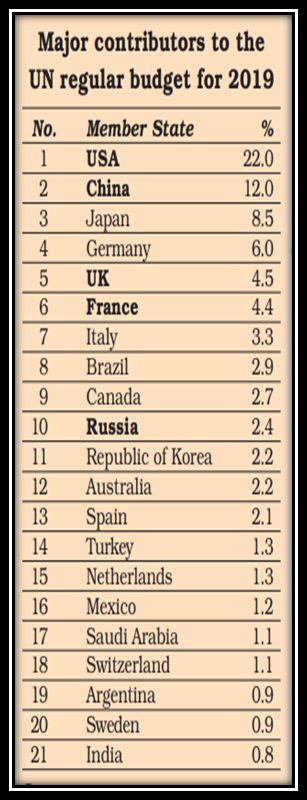 The UN in a Unipolar World
The UN in a Unipolar World
- US power cannot be checked easily because of various reasons. The reasons being:
1. Military Power
- After the disintegration of the USSR, The US big game the superpower and no country code match up its military and economic power. It allows it to ignore the UN or any other international organization.
2. Location of UN
-
- US is the largest contributor to the UN; The US has unmatched financial power.
- The UN is physically located within the US territory which gives Washington source of influence.
- The US has many nationals in the UN bureaucracy
3. Position of US
-
- As US is the permanent member of UN it has veto powers.
- US can stop any moves which it finds is against/damaging its or its friend’s interest.
- Veto power strengthens Washington DC’s stance/choice in selection of UN secretary general.
- The US often uses his powers to “split” the rest of the world and to reduce the opposition to its policies.
- Therefore, UN is not a great balance to the US.
- It brought US and other countries together.
- Leaders of the US appreciate UN for bringing over 190 nations together to deal with conflicts and social and economic development of world.
- UN provides a platform to modify attitude and policies of the US
- It is virtually impossible to balance the power of US, UN provides platform in which specific arguments against US can be heard and discussed, and compromise regarding its policies.
- The UN is an imperfect body but without it the world would be worse off.
-
- It allows interdependence.
-
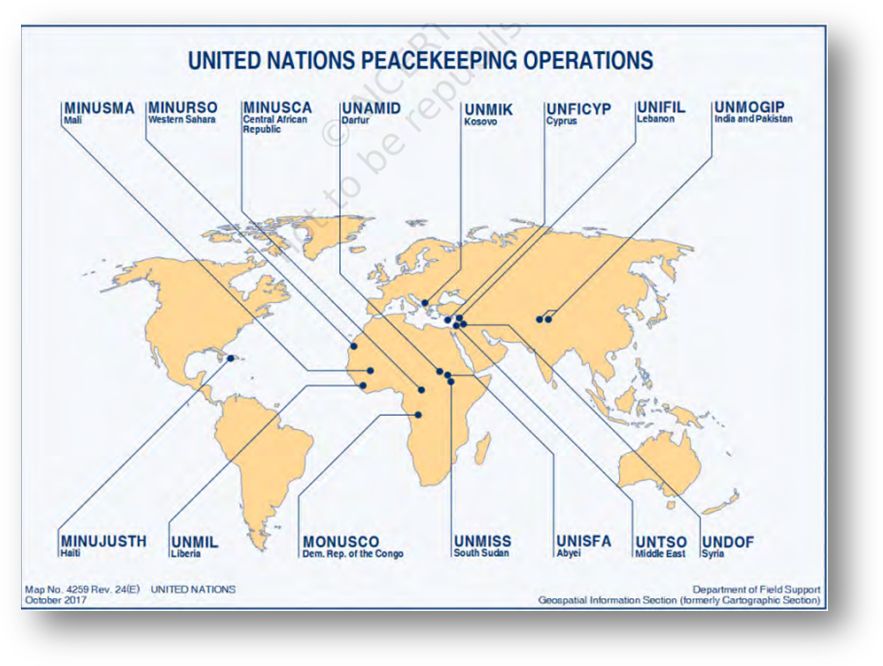
4. Organizations of United Nations
- Books Name
- Education Vision Political Science Book
- Publication
- PathSet Publications
- Course
- CBSE Class 12
- Subject
- Political Science
ORGANIZATIONS OF UN
- The International Monetary Fund (IMF) is an international organisation that oversees those financial institutions and regulations that act at the international level. The IMF has 189 member countries (as on 12 April 2016) but they do not enjoy an equal say. The G-7 members US (16.52%), Japan (6.15%), Germany (5.32%), France (4.03%), UK (4.03%), Italy (3.02%) and Canada (2.22%) have 41.29% of the votes. China (6.09%), India (2.64%), Russia (2.59%) Brazil (2.22%) and Saudi Arabia (2.02%) are the other major members.
- The World Bank was created during the Second World War in 1944. Its activities are focused on the developing countries. It works for human development (education, health), agriculture and rural development (irrigation, rural services), environmental protection (pollution reduction, establishing and enforcing regulations), infrastructure (roads, urban regeneration, electricity) and governance (anti-corruption, development of legal institutions). It provides loans and grants to the member-countries. In this way, it exercises enormous influence on the economic policies of developing countries. It is often criticised for setting the economic agenda of the poorer nations, attaching stringent conditions to its loans and forcing free market reforms.
- The World Trade Organisation (WTO) is an international organisation which sets the rules for global trade. This organisation was set up in 1995 as the successor to the General Agreement on Trade and Tariffs (GATT) created after the Second World War. It has 164 members (as on 29 July 2016). All decisions are taken unanimously but the major economic powers such as the US, EU and Japan have managed to use the WTO to frame rules of trade to advance their own interests. The developing countries often complain of non-transparent procedures and WTO being pushed around by big powers.
- The International Atomic Energy Agency (IAEA) was established in 1957. It came into being to implement US President Dwight Eisenhower’s “Atoms for Peace” proposal. It seeks to promote the peaceful use of nuclear energy and to prevent its use for military purposes. IAEA teams regularly inspect nuclear facilities all over the world to ensure that civilian IAEA reactors are not being used for military purposes
- Amnesty International is an NGO that campaigns for the protection of human rights all over the world. It promotes respect for all the human rights in the Universal Declaration of Human Rights. It believes that human rights are interdependent and indivisible. It prepares and publishes reports on human rights. Governments are not always happy with these reports since a major focus of Amnesty is the misconduct of government authorities. Nevertheless, these reports play an important role AMNESTY INTERNATIONAL in research and advocacy on human rights.
- Human Rights Watch is another international NGO involved in research and advocacy on human rights. It is the largest international human rights organisation in the US. It draws the global media’s attention to human rights abuses. It helped in building international coalitions like the campaigns to ban landmines, to stop the use of child soldiers and to establish the International Criminal Court.
5. Other Organisations / Key Agencies
- Books Name
- Education Vision Political Science Book
- Publication
- PathSet Publications
- Course
- CBSE Class 12
- Subject
- Political Science
OTHER ORGANIZATIONS/ KEY AGENCIES
1. UNESCO
- The United Nations Educational, Scientific and Cultural organization was (UNESCO) established on 4th November 1946.
- With its headquarter in Paris, France, UNESCO is a special body of the United Nations whose main objective is to promote education, natural science, society and anthropology, culture and communication.
During past several years, the special work done by the UNESCO has been to promote literacy, technical and educational training and independent media etc. all across its member nations.
2. UNICEF
- The United Nations International Children’s Emergency Fund was established in 1946 by the United nations General Assembly as body whose main task was to collect emergency funds for children and to help in their development work all across the world.
- Apart from this, UNICEF helps and encourages the work that promote children’s health and better life in all parts of the world.
- With its headquarter in New York, United States, UNICEF has been working successfully in almost all 193 countries of the world
3. ILO
- The International Labour Organization, founded in October 1919 with its headquarter in Geneva, Switzerland, is a body of the United Nations which aims to promote efficient conditions of social justice and work for workers through international labour standards at the global level.
- In addition, there is an incentive for women and male worker to engage in productive work and to create safety, parity and self-respectful conditions for them at the workplace.
2. Association of South East Asian Nations
- Books Name
- Education Vision Political Science Book
- Publication
- PathSet Publications
- Course
- CBSE Class 12
- Subject
- Political Science
ASSOCIATION OF SOUTH EAST ASIAN NATIONS(ASEAN)
- Association of South East Asian Nations.
- ASEAN was established in 1967 by signing of Bangkok Declaration, by 5 countries of the region, namely:
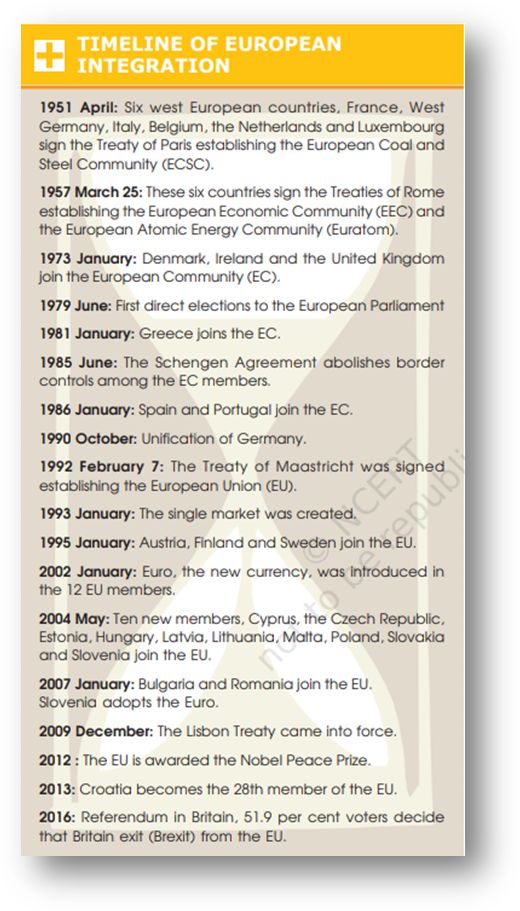 Indonesia
Indonesia - Malaysia
- Philippines
- Singapore
- Thailand
- Later South East Asia region joined, namely:
- Brunei Darussalam
- Lao PDR
- Myanmar (Burma)
- Vietnam
- Cambodia
joined making total count to 10.
- The objectives of ASEAN were to accelerate economic growth and through that ‘social progress and cultural development’ and promote regional peace and stability based on the rule of law and the principles of the United Nations Charter.
- After the Second World War, when the war ended Asia confronted problems of nation building, ravages of poverty and economic backwardness and the pressure to align with great power and therefore for informal corporation interaction ASEAN was formed.
- ASEAN countries celebrate a day known as “ASEAN WAY” in which these countries do not talk about any war, it is informal and cooperative talk.
- Its aim is to achieve sovereignty.
- In 2003, ASEAN decided to evolve like European Union, so established ASEAN community also known as the 3 pillars, namely:
- The ASEAN Security Community
- The ASEAN Economic Community
- The ASEAN Socio-Cultural Community
- ASEAN Security Community
- It was made because, if there was a dispute among neighboring countries regarding territory, they solve it by talking politely without any war.
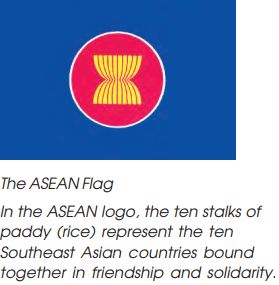
- ASEAN sign several agreements in which the member states promise to maintain peace, stay neutral, always cooperate, non-interference and respect for the national differences and sovereign rights.
- The ASEAN regional forum, it was established in 1994, this organization carries out coordination of security and foreign policy
- ASEAN Economic Community
- Its objective is to create a common market and production base within ASEAN states and to aid social and economic development in the region.
- It has focused on creating a Free Trade Area (FTA) for investment, labor, and services.
- ASEAN community it’s also interested in resolving the old economic disputes.
- The US and China have already moved fast to negotiate FTAs with ASEAN.
- ASEAN has sorted out 2 biggest disputes that is,
- Cambodian conflict,
- the East Timor crisis
- The Cultural Economic Strength
- Attractive partners for trade of India and China.
- During the Cold War years Indian foreign policy did not pay adequate attention to ASEAN, but now it has signed trade agreements with 3 ASEAN members, Malaysia, Singapore and Thailand.
- The ASEAN- India FTA came into effect in 2010.
The reason for ASEAN being powerful is that they, interact and corporate with each other.

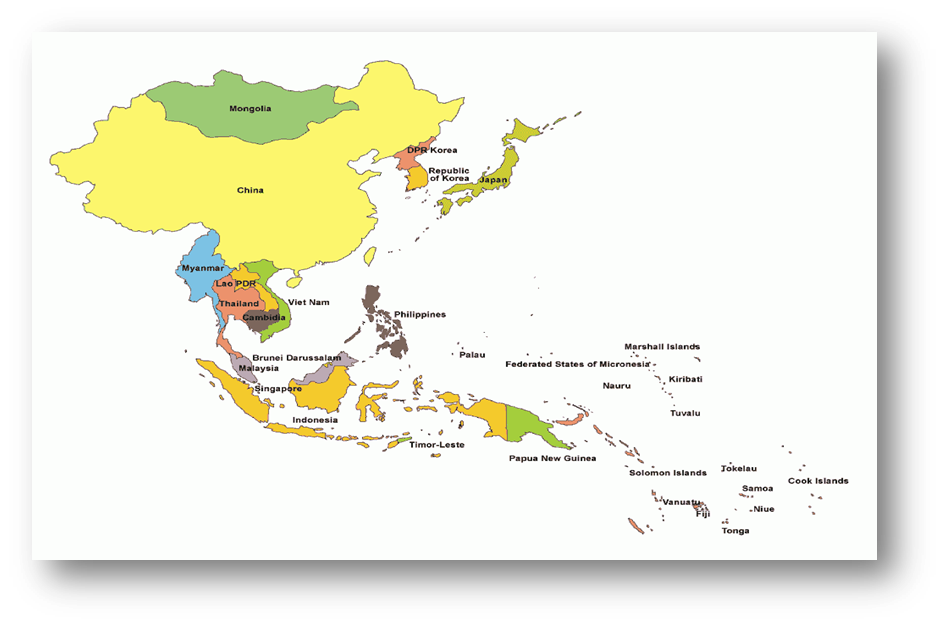
3. The Rise of the Chinese Company
- Books Name
- Education Vision Political Science Book
- Publication
- PathSet Publications
- Course
- CBSE Class 12
- Subject
- Political Science
THE RISE OF THE CHINESE ECONOMY
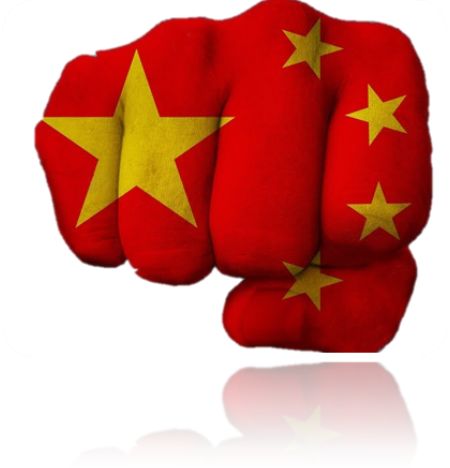
- Chinese Economy started rising in 1978. It is predicted that by 2040 it will day overtake U.S. as the world’s largest economy.
- In 1949 People’s Republic of China started, in which China adopted USSR’s ideology that is communism and cancelled USA’s ideology that is capitalism (As China was weak at that time). So, they chose Soviet model under the leadership of Mao.
- China became an isolated country (no relation with other countries) , Decreased imports because it was short on foreign exchange.
- Economic Context – Aid from USSR
- Economic growth was increasing but population growth was also increasing which was not in balance of economic growth.
- USSR crisis (disintegration) because of which China suffered.
- Industrial Production was not growing fast enough, international trade was minimal and per capita income was very low.
- In 1972 (Leader) Premier Zhou Enlai proposed to end the isolation.
- Then in 1972 China started its relations with US
- PM of china i.e., Zhou Enlai proposed the ‘four modernizations’ in 1973, in which he told they will increase:
- Industry
- Agriculture
- Military Power
- Science and Technology
- In 1978, leader i.e., Deng Xiaoping announced the “open door” policy i.e., China opened its doors for foreign trade and investments.
- China adopted privatization i.e., Market Economy –(no shock therapy).
- They slowly started moving towards capitalism
- 1992- privatization of Agriculture
- 1998 – Privatization of Industries.
- Trade barriers were eliminated only in Special Economic Zones (SEZs) where foreign investor could set up enterprises.
- Trade started and tariffs were removed/reduced. Foreign direct investment increased.
- China became the most important destination for foreign direct investment (FDI).
- In 2001, China became part of World Trade Organization (WTO).
- As the economy rose China still faced problems like:
- Unemployment with almost 100 million people looking for job.
- Environmental Degradation rose high
- Corruption rate also increased
- Rise in economic inequality between rural and urban residents and coastal and inland provinces.
- China is a permanent member of UN.
- China started having issues with ASEAN, Japan, the US and Russia.
4. INDIA-CHINA Relations
- Books Name
- Education Vision Political Science Book
- Publication
- PathSet Publications
- Course
- CBSE Class 12
- Subject
- Political Science
India-China Relations
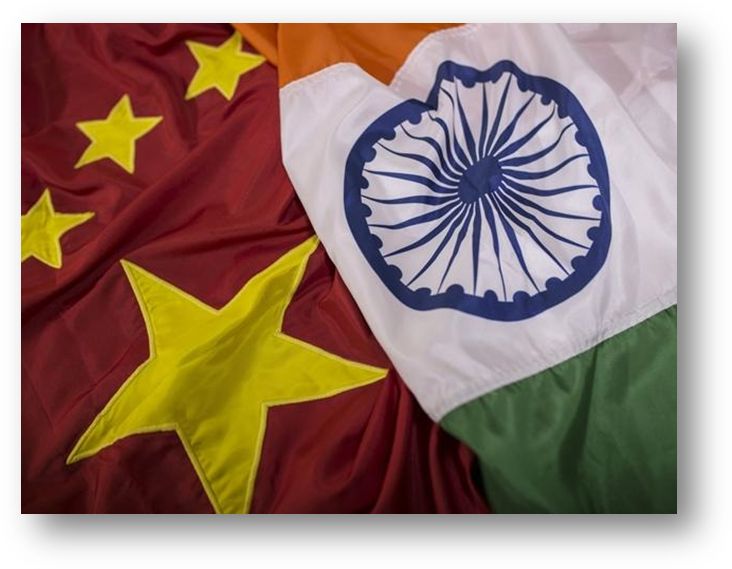
- India and China were great powers of Asia before the advent of Western Imperialism.
- In 20th Century, both nations confronted each other, they had some difficulty evolving a foreign policy to deal with each other.
- For a brief while, the slogan of ‘ Hindi-Chini bhai-bhai’ was popular.
- A military conflict over a border dispute between the two countries marred the hope.
- China and India have been in conflict in 1950 over Tibet issue.
- And also, in border conflicts in 1962 principally in Arunachal Pradesh and Ladakh.
- Diplomatic relations of both countries were downgraded until 1976.
- Slowly the relations of both the countries started improving, when the China’s political leadership changed in mid to late 1970’s.
- 1981- Steps were taken to resolve the border issues.
- 1988- Rajiv Gandhi visited China, since then both governments have taken measures to contain conflict and maintain ‘peace and tranquility’ on the border.
- 1999 – trade between both countries have increased from 30 percent
- Bilateral trade between India and China has increased from $338 million in 1992 to more than $84 billion in 2017.
- At global level both the countries have adopted similar policies in international economic situation like WTO.
- India’s nuclear test of 1998, justified on the grounds of a threat from China, and did not stop greater interaction.
- There is a positive relation between the two countries.
2. The Military and Democracy in Pakistan
- Books Name
- Education Vision Political Science Book
- Publication
- PathSet Publications
- Course
- CBSE Class 12
- Subject
- Political Science
The Military and Democracy in Pakistan
- Sequence of Rule:
- General Ayub Khan
- General Yahya Khan
- Elected Government of Zulfikar Ali Bhutto (1971-77)
- General Zia-ul-Haq
- Benazir Bhutto
- Nawaz Sharif
- General Musharraf
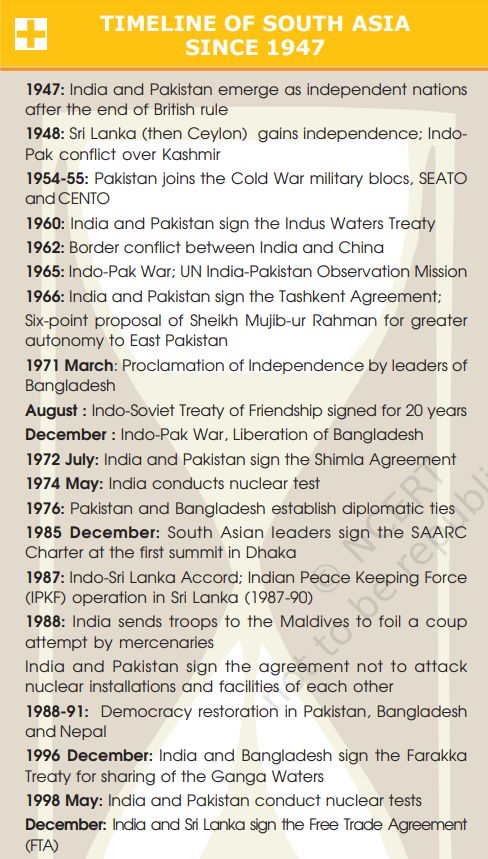
- After first constitution was formed general Ayub Khan, got himself elected.
- Dissatisfaction with his rule, there was military took over by General Yahya Khan.
- During Yahya’s rule Pakistan faced Bangladesh crisis, and after a war with India in 1971, East Pakistan broke away and emerged as an independent country called Bangladesh.
- After this, elected government of Zulfikar Ali Bhutto was in power in Pakistan from 1971 to 1977.
- Bhutto government was removed by General Zia-ul-Haq in 1977.
- In 1982, there was pro-democracy movement by people and again an elected government took over in 1988 under leadership of Benazir Bhutto.
- Benazir Bhutto was daughter of Zulfikar Ali Bhutto.
- After she became the P.M. in 1988 political system prevailed in Pakistan just like Indian democracy.
- There were two parties in total namely the Pakistan People’s Party and the Muslim League.
- Benazir Bhutto was of Pak istan People’s Party.
- The democracy lasted till 1999. And General Pervez Musharraf removed the current P.M. Nawaz Sharif.
- In 2001, General Musharraf got himself elected as President.
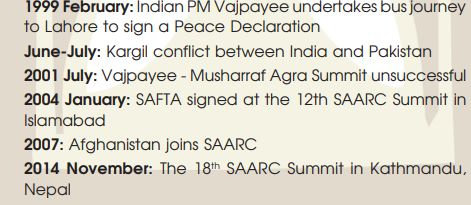
- It continued to be ruled by army, yet rulers have held elections to give their rule a democratic image.
- Since 2008, democratically elected rulers have been ruling Pakistan.
- Factors responsible for failure of stable democracy building in Pakistan:
- Social dominance of the military, clergy, and landowning aristocracy.
- Conflicts with India made pro-military groups more powerful.
- Some think that Pakistan’s security would be harmed by selfish-minded people/parties so therefore army’s stay in power is justified.
- The lack of genuine international support for democratic rule, has further encouraged the military dominance in Pakistan.
- The United Stated and other Western countries have encouraged military rule for their own reasons.
- Other countries also feared from the threat of ‘global Islamic terrorism’ and the apprehension that Pakistan’s nuclear arsenal might fall into the hands of terrorist groups.
- The military regime in Pakistan has been seen as the protector of the Western interests in West Asia and South Asia.
- Pakistan population has a pro-democracy sentiment and there is free press and a strong human rights movement.
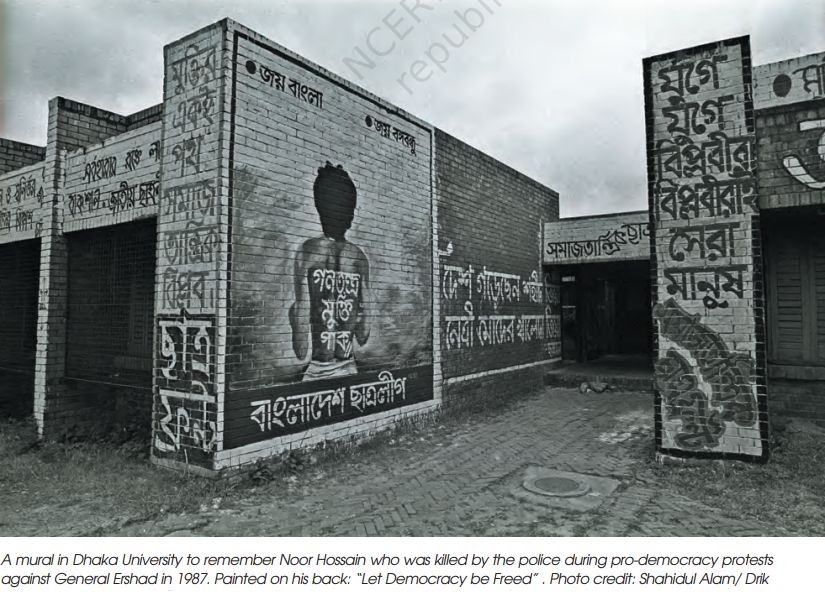
3. Democracy in Bangladesh
- Books Name
- Education Vision Political Science Book
- Publication
- PathSet Publications
- Course
- CBSE Class 12
- Subject
- Political Science
DEMOCRACY IN BANGLADESH
- Bangladesh was a part of Pakistan from 1947 to 1971.
- It consisted partitioned areas of Bengal and Assam from British India.
- The people here resented over the domination of wester Pakistan and the imposition of the Urdu language.
- After the partition people started protesting against the unfair treatment towards Bengali culture and language.
- They demanded fair representation in administration and a fair share in political power.
- Sheikh Mujib-ur Rahman led the popular struggle again the West Pakistani domination, he demanded autonomy for eastern regions. He demanded complete autonomy for eastern regions.
- In 1970, elections were held in Pakistan. The Awami League led by Sheikh Mujib won all seats in East Pakistan and secured a majority in constituent assembly.
- But the West Pakistan leadership refused to convene the assembly.
- Sheikh Mujib was arrested.
- Yahaya Khan, the Pakistani army tried to supress Bengali mass movement of people.
- Thousands were killed and there was wide scale migration to India.
- Government of India supported East Pakistan and helped them financially and militarily.
- Which led to war between India and Pakistan in December 1971, Pakistan army surrendered and the formation of Bangladesh as an independent country was successful.
- Bangladesh after independence from West Pakistan:
- Bangladesh drafted its constitution in declaring its faith in secularism, democracy and socialism.
- In 1975, Sheikh Mujib got the constitution amended to shift from the parliamentary to presidential form of government.
- He abolished all the parties except its own the Awami League. He was assassinated in a military uprising in August 1975.
- The new military ruler, Ziaur Rahman, formed his own Bangladesh National Party and won the elections in 1979.
- He was assassinated which was then followed by another military takeover by Lt Gen H.M.Ershad.
- The people of Bangladesh rose in favour for democracy, and the students were in forefront and Ershad allowed political activity on a limited scale.
- Ershad was later elected as president for 5 years, followed by mass public protests he had to step down in 1990.
Elections were held in 1991, and thereafter democracy based on multi-party system has been working in Bangladesh.
4. Nepal : Monarchy & Democracy
- Books Name
- Education Vision Political Science Book
- Publication
- PathSet Publications
- Course
- CBSE Class 12
- Subject
- Political Science
MONARCHY AND DEMOCRACY IN NEPAL
- Nepal was a Hindu Kingdom in the past and then a constitutional monarchy for many years.
- People always wanted democracy, but the King with the help of the army always restricted the expansion of democracy in Nepal and retained full control over government.
- There were pro-democracy movements and king accepted the demand for new democratic constitution in 1990.
- Democratic government had a troubled career, in nineties Maoists spread their influence, they believed in armed insurrection against the monarch and the ruling elite.
- This led to a triangular conflict among the monarchist forces, the democrats and the Maoists.
- In 2002, the king dismissed the government.
- In 2006, there was massive pro-democracy protests, they first victory was when the king was forced to restore the House of Representatives which was dissolved in April 2002.
- The non- violent movement was led by the Seven Party Alliance (SPA), the Maoists and social activists.
- Nepal transition to democracy is ongoing:
- Its constituent assembly is still drafting its constitution.
- Some think nominal monarchy is important to retain its link with past
- Maoist wanted the constitution to include the radical programmes of social and economic restructuring
- The Maoists and some other political parties were suspicious of the Indian government and its role in the future of Nepal.
- Nepal became democratic republic in 2008.
- In 2015 it adopted a new constitution.
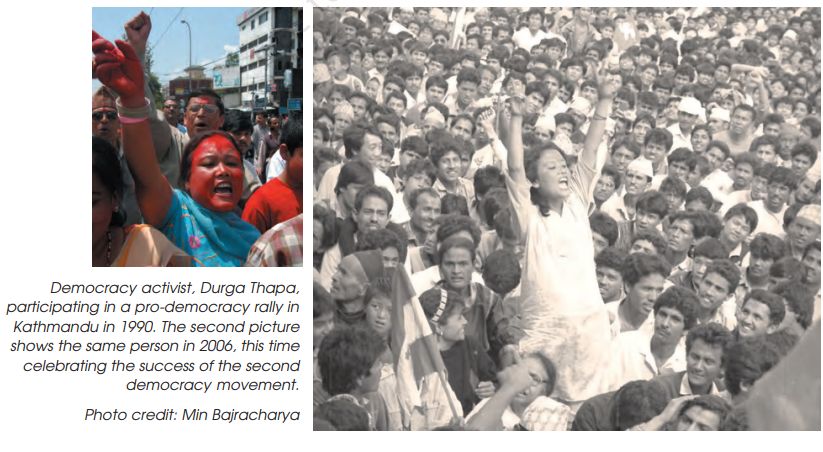
ETHNIC CONFLICT AND DEMOCRACY IN SRI LANKA
- Sri Lanka got independence in 1948.
- Sri Lanka was earlier known as Ceylon.
- After India’s independence many Tamils migrated from India to Sri Lanka and settled there, migration continued even after independence.
- Sinhala’s nationalists did not want Tamils from India to come to Sri Lanka as they believed Sri Lanka belonged to Sinhala people only, it led to militant Tamil nationalism.
- From 1983, the militant organization, the Liberation Tigers of Tamil Eelam (LTTE) has been fighting with the army of Sri Lanka and demanding “Tamil Eelam” i.e., separate country for Tamils of Sri Lanka.
- The LTTE controlled the northeasters parts of Sri Lanka.
- The Government of India has negotiating with Sri Lankan government on Tamil question, in 1987 the Indian government got involved with in Sri Lankan Tamil question.
- And signed an accord with Sri Lanka and sent troops to stabilise relations between Sri Lankan government and the Tamils.
- And Indian Army got into fight with LTTE and this was seen as India interfering in internal affairs of Sri Lanka.
- And in 1989, the Indian Peace Keeping Force (IPKF) pulled out without attaining its objectives.
- The Sri Lankan crisis continued to be violent, Norway and Iceland tried to bring the warring groups to negotiations.
- The conflict came to an end, as LTTE was vanquished in 2009.
- Sri Lanka was one of the first developing countries to successfully control the rate of growth population, also first to liberalise the economy and it had highest per capita GDP for many years.
- Despite of internal conflicts it has maintained a democratic political system.
5. India-Pakistan Conflicts
- Books Name
- Education Vision Political Science Book
- Publication
- PathSet Publications
- Course
- CBSE Class 12
- Subject
- Political Science
INDIA-PAKISTAN CONFLICTS
- Fate of Kashmir
- War of 1947-49 and 1965 failed to settle the conflict over the fate of Kashmir.
- War of 1947-48 resulted in division of province occupied by Kashmir and the Indian province of Jammu and Kashmir by the Line of Control.
- War of 1971 was won by India but the Kashmir issue was still not settled.
- War of 1947-49 and 1965 failed to settle the conflict over the fate of Kashmir.
- Strategic Issues
- Control over Siachen glacier
- Acquisition of arms
- India tested its 1st weapon nuclear explosion in Pokaran.
- Pakistan in return conducted its nuclear tests in Chagai Hills.
- Both have built a military relationship where possibility of a direct and full-scale war has declined.
- Suspicious Government
- Both the country’s government doubt on each other.
- Terrorist Activity
- Indian Government blames Pakistan for helping Kashmir militants to carry out terrorist strikes against India.
- Indian Government also believes that Pakistan had aided the pro-Khalistani militants with ammunitions during the period of 1985-1995.
- Pakistan’s spy agency Inter Services Intelligence (ISI), has also been accused for being involved in anti-India campaigns in northeast part of India.
- In return Pakistan blames Indian Government to promote trouble in the provinces of Sindh and Baluchistan.
- River Water Disputes
- Till 1960, there was argument regarding the use of the rivers of the Indus basin.
- In 1960, Indus Water Treaty was signed between the two countries with the help of World Bank.
- But despite of the treaty signed both the countries are not in demarcation line in Sir Creek in the Rann of Kutch.
- India and Pakistan are holding negotiations on all the issues.
6. India and Its other Neighbours
- Books Name
- Education Vision Political Science Book
- Publication
- PathSet Publications
- Course
- CBSE Class 12
- Subject
- Political Science
INDIA AND ITS OTHER NEIGHBOURS
- Bangladesh:
- 1st conflict – sharing of river water of Brahmaputra and Ganga river waters.
- Indian government does not like
- Denial off Bangladesh on illegal immigration of people to India.
- Its support for anti-Indian Islamic fundamentalist groups.
- Bangladesh’s refusal to allow Indian troops to move through its territory.
- Bangladesh’s decision not let India/Myanmar to export natural gas through its territories.
- Bangladesh government feels that
- Indian government behaves like a regional bully over sharing river
- Indian government’s encouragement of rebellion in Chittagong Hill tracts.
- Indian government is trying to extract its natural gas and being unfair in trade.
- Economic relations of both the countries have improved considerably.
- Bangladesh is part of India’s Look East policy.
- Both the countries have regularly cooperated on disaster management and environmental issues.
- In 2015, they have also exchanged certain enclaves
- Nepal
- Both the countries have a special relation.
- A treaty between two countries allows the citizens of both the countries to travel and work in the other country without visas and passports.
- Conflicts:
- India does not like the warm relationship between Nepal and China.
- India also does not like Nepal government’s no action against anti-Indian elements.
- Indian security agencies see the Maoist movement in Nepal as a security threat.
- Nepal citizens/government feel that Indian government interferes in Nepal’s internal affairs, has its design on its river-waters.
- Nepal government also feels Indian government stops Nepal from getting easier access to the sea through Indian territories.
- Despite all the differences, trade, natural resources etc. hold the two countries together.
- Sri Lanka
- The difficulties in the relationship between both the governments of both the countries are over ethnic conflicts.
- Indian leaders cannot remain neutral when Tamils in the Sri Lanka are unhappy and are being killed.
- After military intervention in 1987, the Indian government stick to the policy of disengagement vis- à-vis Sri Lanka’s internal troubles.
- India has signed a free trade agreement.
- India’s help in post-tsunami reconstruction in Sri Lanka has also brought the two countries closer.
- Bhutan
- Both have a special relationship.
- The efforts by Bhutanese monarch to throw out the militants and guerrillas from their country has been helpful to India.
- India is also involved in big hydroelectric projects in Bhutan and remains Himalayan kingdom’s biggest source of development aid.
- Maldives
- They have a good and warm relations.
- In November 1988, Maldives requested India to help stop invasion by Tamil mercenaries and it reacted quickly to its request and helped.
- India has also contributed toward the island’s economic development, fisheries etc.
- Majorly conflicts of India and other countries is because of the geography of the region, as India is situated centrally and is therefore the only country that borders others.
Peace and Cooperation
- SAARC (South Asian Association for Regional Cooperation), it is initiative by the South Asian states to cooperate through multilateral means
- SAARC begun in 1985.
- SAARC member signed the South Asian Free Trade (SAFTA), it promised the formation of a free trade zone for the whole of South Asia.
- SAFTA was signed in 2004 and came into effect on 1 January 2006.
- Objectives SAFTA:
- Establishing free trade regime in South Asia
- Lowering trade tariffs.
- India believes that there are economic benefits of for all from SAFTA.
- Some in India also think that as India already has bilateral agreements with Bhutan, Nepal and Sri Lanka so it is not worth the trouble.
- Cooperation of India-Pakistan:
- Friendly atmosphere
- Confidence building measures have been taken by both countries.
- Both countries attend summits, UN meeting to better understand each other’s problem and find solution accordingly.
- Bus routes (2005) has started between India and Pakistan.
- Visa’s are also given easily.
- China and the United States are key players of South Asian politics.
- Sino-Indian relations has improved in last 10 years, but China’s partnership with Pakistan is a major irritant.
- Demands of development has brought China and United States together and economic ties have multiplied rapidly since 1991.
- The US is also a moderator in India-Pakistan relations.
SAARC
- South Asian Association for Regional Cooperation, it was established with the signing of SAARC charter in Dhaka in 1985.
- Founding member of SAARC:
- Bangladesh
- Bhutan
- India
- Maldives
- Nepal
- Pakistan
- Sri Lanka
- Afghanistan joined SAARC in 2007
- Its permanent headquarter is in Kathmandu, Nepal.
- Objectives of SAARC:
- To promote the welfare of the people of South Asia and to improve their quality of life.
- To accelerate economic growth, social progress and cultural development in the region and to provide all individuals opportunity to live in dignity and to realise their full potential.
- To promote and strengthen collective self-reliance among the countries of South Asia.
- To contribute to mutual trust, understanding and appreciation of one another problems
- To promote active collaboration and mutual assistance in the economic, social, cultural, technical and scientific fields.

 PathSet Publications
PathSet Publications
